#danish knitting movement
Photo





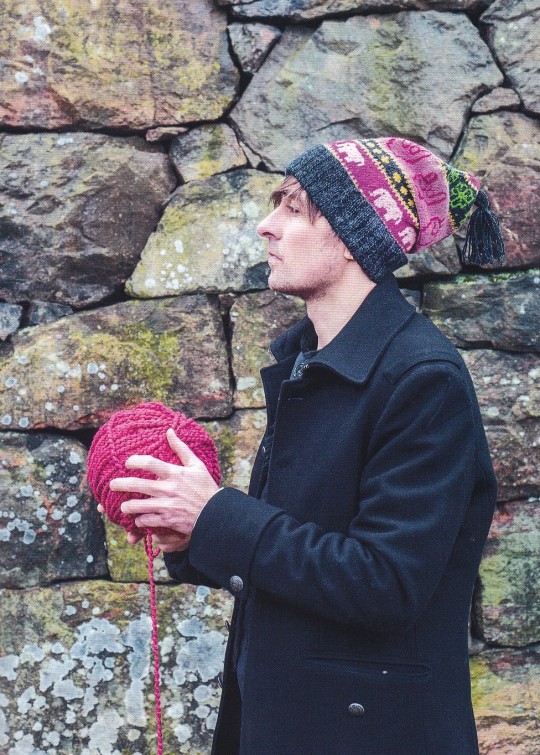




Alterknit Rebellion
Radical Patterns for Creative Knitters
Anna Bauer
David & Charles, Pynes Hill 2020, 103 pages, 19 x 24 cm.,paperback, ISBN 978-1446308271
euro 25,00
email if you want to buy :[email protected]
A collection of bright, bold and beautiful knitting patterns based on Honsestrikk, a Danish knitting movement from the 1970s which broke away from traditional knitting rules.
Honsestrikk, which loosely translates as 'chicken stitch' was influenced by the radical social and political movements of the time, including the women's rights movement, and this can be seen in the personal and political messages of the some of the pattern designs. Instead of the more traditional fair isle colourwork techniques, Honsestrikk knitting featured political messages and motifs, colours clashed and borders butted up against each other in a riot of colour and pattern.
Honsestrikk is about knitting in a freer style so you have the freedom to express yourself and create truly unique, personalized garments and accessories.
Designer Anna Bauer has been inspired by the Honsestrikk movement to create this collection of basic designs and patterns so you can choose your own combinations and create and knit your own free, radical knits.
24/10/22
orders to: [email protected]
ordini a: [email protected]
twitter: @fashionbooksmi
instagram: fashionbooksmilano, designbooksmilano tumblr: fashionbooksmilano, designbooksmilano
#Alterknit Rebellion#radical patterns#creative knitters#Honsestrikk#danish knitting movement#maglieria#knitting books#fashion books#fashionbooksmilano
5 notes
·
View notes
Text

So I got this tag on my answer to an ask about when it became acceptable for western women to wear pants, and you know it's all I need to go on a tangent.
I think the short answer here would be men have worn skirts as long as people have worn anything, so pretty long tbh. But since I am incapable of answering anything shortly, I think we can re-frame this question:
When did skirts stop being socially acceptable for men?
So let's start with acknowledging that tunics, togas, kirtles and such men wore through history were, in fact, skirts. I think there's often a tendency to think of these as very different garments from those that women wore, but really they are not. Most of the time they were literally referred to with the same name. (I will do a very broad and simplified overview of men's clothing from ancient times to Early Middle Ages so we can get to the point which is Late Middle Ages.)
Ancient Greek men and women both wore chitons. Even it's length wasn't determined by gender, but by occupation. Athletes, soldiers and slaves wore knee-length chitons for easier movement. Roman men and women wore very similar garment, tunics. Especially in earlier ancient Rome long sleeves were associated with women, but later became more popular and unconventional for men too. Length though was still dependent on occupation and class, not gender. Toga was sure men's clothing, but worn over tunic. It was wrapped around the waist, like a dress would, and then hung over shoulder. Romans did wear leggings when they needed to. For example for leg protection when hunting as in this mosaic from 4th century. They would have been mostly used by men since men would be doing the kinds of activities that would require them. But that does not lessen the dressyness of the tunics worn here. If a woman today wears leggings under her skirt, the skirt doesn't suddenly become not a skirt.
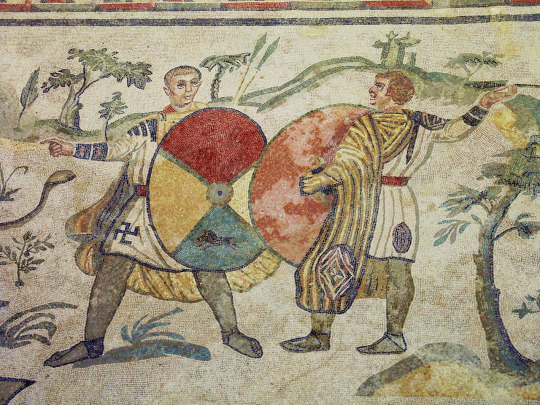
All over Europe thorough the early Middle Ages, the clothes were very similar in their basic shape and construction as in Rome and Greece. In Central and Northern Europe though people would wear pants under shorter tunics. There were exceptions to the everyone wearing a tunic trend. Celtic men wore braccae, which were pants, and short tunics and literally just shirts. Celts are the rare case, where I think we can say that men didn't wear dresses. Most other peoples in these colder areas wore at least knee-length tunics. Shorter tunics and trousers were worn again mostly by soldiers and slaves, so rarely any other woman than slave women. The trousers were though definitely trousers in Early Middle Ages. They were usually loose for easier construction and therefore not that similar to Roman leggings. However leggings style fitted pants were still used, especially by nobility. I'd say the loose trousers are a gray area. They wore both dresses and pants, but still definitely dresses. I'd say this style was very comparable to the 2000s miniskirts over jeans style. First one below is a reconstruction of Old Norse clothing by Danish history museum. The second is some celebrity from 2005. I see no difference.
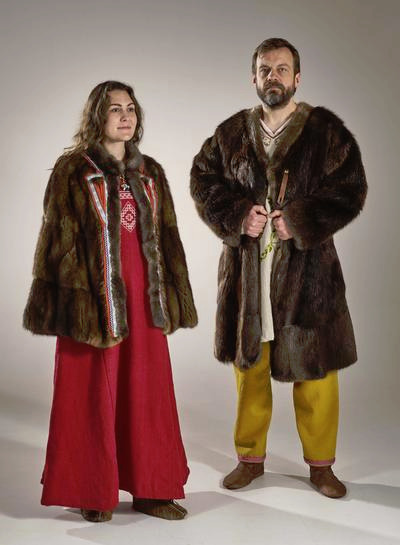
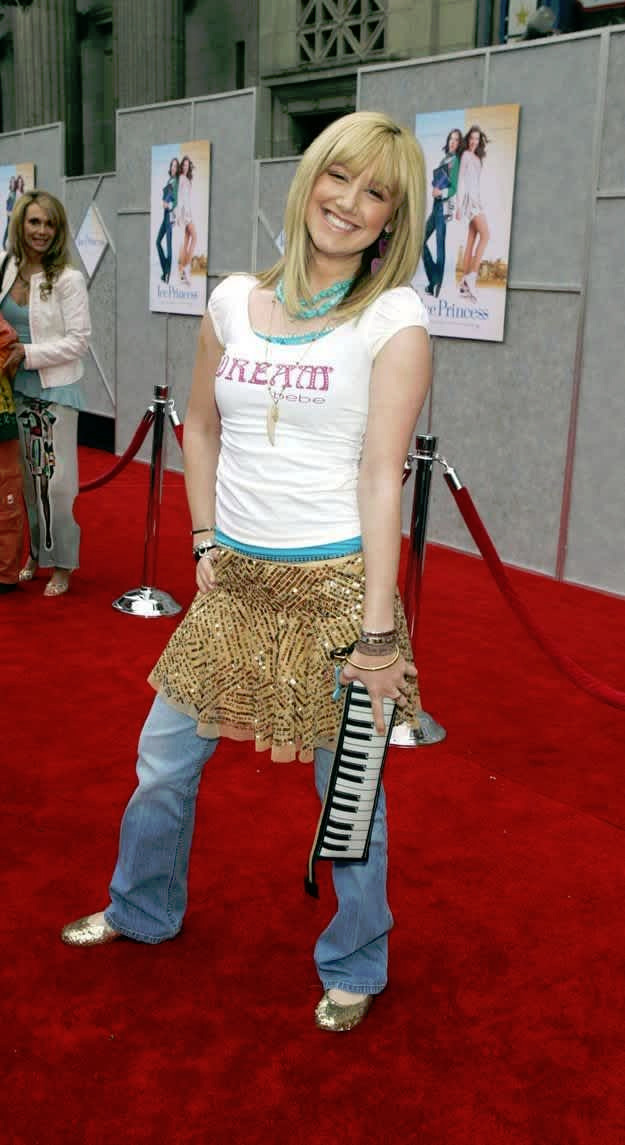
When we get to the high Middle Ages tunics are still used by both men and women, and still it's length is dependent on class and activity more than gender, but there's some new developments too. Pants and skirt combo is fully out and leggings' are back in in form of hose. Hose were not in fact pants and calling them leggings is also misleading. Really they are socks. Or at least that's how they started. As it has become a trend here they were used by everyone, not just men. During early Middle Ages they were worn often with the trousers, sometimes the trousers tucked inside them making them baggy. In high Middle Ages they became very long when used with shorter tunics, fully displacing the need for trousers. They would be tied to the waist to keep them up, as they were not knitted (knitting was being invented in Egypt around this time, and some knitting was introduced to Europe during middle Ages, but it really only took off much later during Renaissance Era) and therefore not stretchy. First picture is an example of that from 1440s. Another exciting development in the High Medieval era was bliaut in France and it's sphere of influence. Bliaut was an early attempt in Europe of a fitted dress. And again used by both men and women. The second illustration below from mid 12th century shows a noble man wearing a bliaut and nicely showing off his leg covered in fitted hose. Bliaut was usually likely fitted with lacing on the sides, but it wasn't tailored (tailoring wasn't really a thing just yet) and so created a wrinkled effect around the torso.
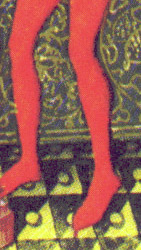

In the 14th century things really picked up in European fashion. European kingdoms finally started to become richer and the rich started to have some extra money to put into clothing, so new trends started to pop up rapidly. Tailoring became a thing and clothes could be now cut to be very fitted, which gave birth to fitted kirtle. At the same time having extra money meant being able to spend extra money on more fabric and to create very voluminous clothing, which gave birth to the houppelande.
Kirtle was once again worn by everyone. It wasn't an undergarment, for women that would be shift and men shirt and breeches, but it was an underlayer. It could be worn in public but often had at least another layer on top of it. The bodice part, including sleeves were very fitted with lacing or buttons (though there were over-layer kirtles that had different sleeves that changed with fashions and would be usually worn over a fitted kirtle). Men's kirtles were short, earlier in 14th century knee-length but towards the end of the century even shorter styles became fashionable in some areas. First picture below shows a man with knee-length kirtle from 1450s Italy.
Houppelande was also unisex. It was a loose full-length overgown with a lot of fabric that was gathered on the neckline and could be worn belted or unbelted. The sleeves were also wide and became increasingly wider (for men and women) later in the century and into the next century. Shorter gowns similar in style and construction to the houppelande were also fashionable for men. Both of these styles are seen in the second picture below from late 14th century.
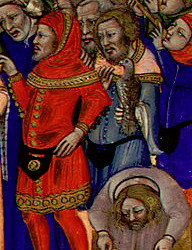

In the very end of 14th century, first signs of pantification of men can be seen. In France and it's sphere of influence the skirt part of the kirtle became so short it barely covered the breeches as seen below on these fashionable musicians from 1395-1400 France. Long houppelandes, length ranging from floor to calf, were still used by men though (the second picture, 1414 France), as were knee and thigh length gowns of similar loose style.


The hems continued to be short through the 15th century in France, but in other places like Italy and German sphere of influence, they were still fairly long, at least to mid thigh, through the first half of the century. In France at some point in late 13th century the very short under-kirtle started to be called doublet and they are just getting shorter in 1400s. The showing underwear problem was fixed by joined hose and the codpiece, signaling the entrance of The Sluttiest Era of men's fashion. Below is an example from 1450s Belgium of doublet and early codpiece in display. As you can see from the other figures, the overgowns of the previous century were also getting very, very short. In the next French example below from 1470s we can see the skirt shrink out of existence right before our eyes.
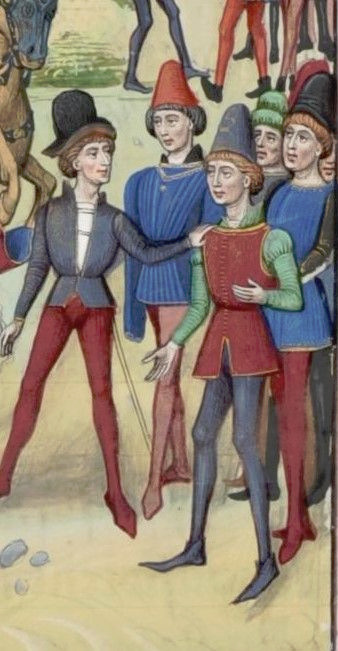

The very skimpy doublet and it's accompanying codpiece spread to the rest of the Europe in the second half of 15th century and it would only get sluttier from there. The Italians were just showing their full ass (example from 1490s). The dress was not gone yet though. The doublet and codpiece continued to be fashionable, but the overdress got longer again in the French area too. For example in the second example there's Italian soldiers in a knee length dresses from 1513.
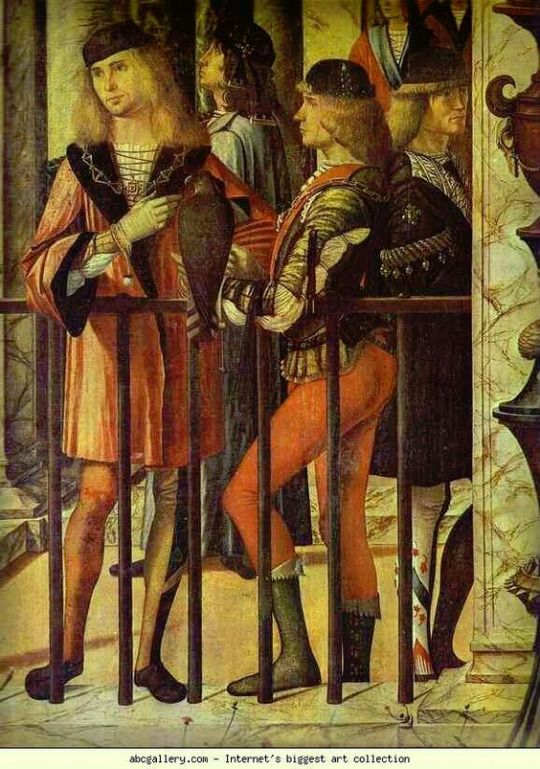
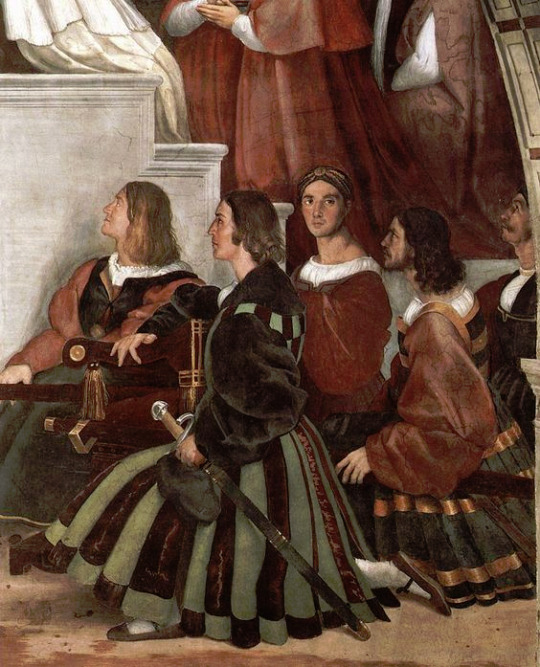
But we have to talk about the Germans. They went absolutely mad with the whole doublet and codpiece. Just look at this 1513 painting below (first one). But they did not only do it sluttier than everyone else, they also changed the course of men's fashion.
Let's take a detour talking about the Landsknecht, the mercenary pikeman army of the Holy Roman Empire. (I'm not that knowledgeable in war history so take my war history explanation with a grain of salt.) Pikemen had recently become a formidable counter-unit against cavalry, which earlier in the Medieval Era had been the most important units. Knights were the professional highly trained cavalry, which the whole feudal system leaned against. On the other hand land units were usually not made of professional soldiers. Landsknecht were formed in late 15th century as a professional army of pikemen. They were skilled and highly organized, and quickly became a decisive force in European wars. Their military significance gave them a lot of power in the Holy Roman Empire, some were even given knighthood, which previously wasn't possible for land units, and interestingly for us they were exempt from sumptuary laws. Sumptuary laws controlled who could wear what. As the bourgeois became richer in Europe in late Middle Ages and Renaissance Era, laws were enacted to limit certain fabrics, colors and styles from those outside nobility, to uphold the hierarchy between rich bourgeois and the nobles. The Landsknecht, who were well payed mercenaries (they would mutiny, if they didn't get payed enough), went immediately absolute mad with the power to bypass sumptuary laws. Crimes against fashion (affectionate) were committed. What do you do, when you have extra money and one of your privileges is to wear every color and fabric? You wear every color and fabric. At the same time. You wear them on top of each other and so they can be seen at the same time, you slash the outer layer. In the second image you can feast your eyes on the Landsknecht.


Just to give you a little more of that good stuff, here's a selection of some of my favorite Landsknecht illustrations. This is the peak male performance. Look at those codpieces. Look at those bare legs. The tiny shorts. And savor them.
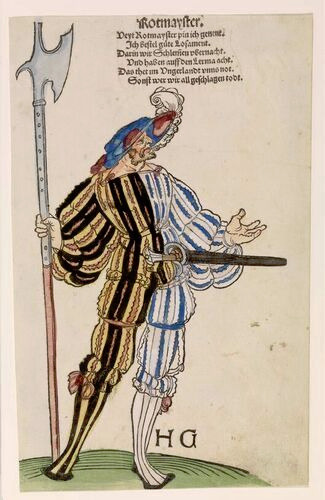
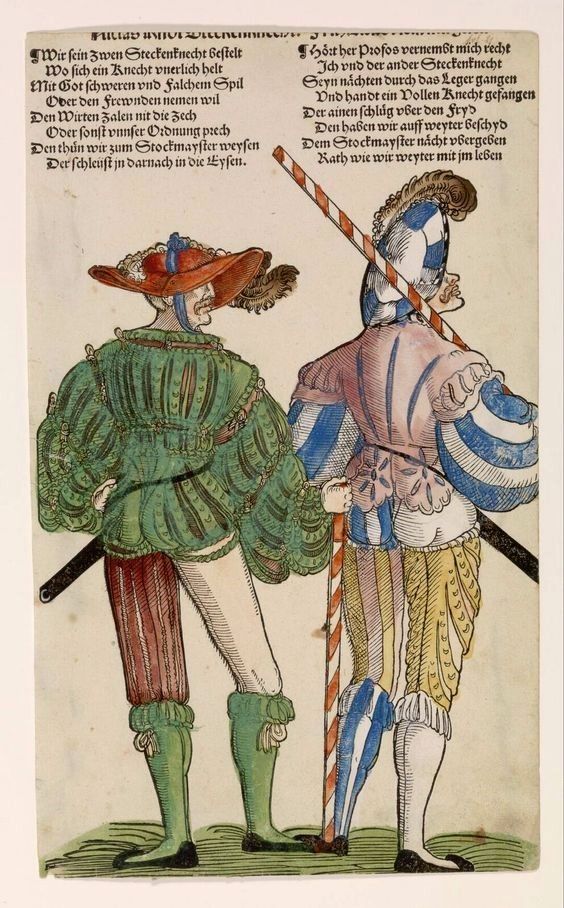
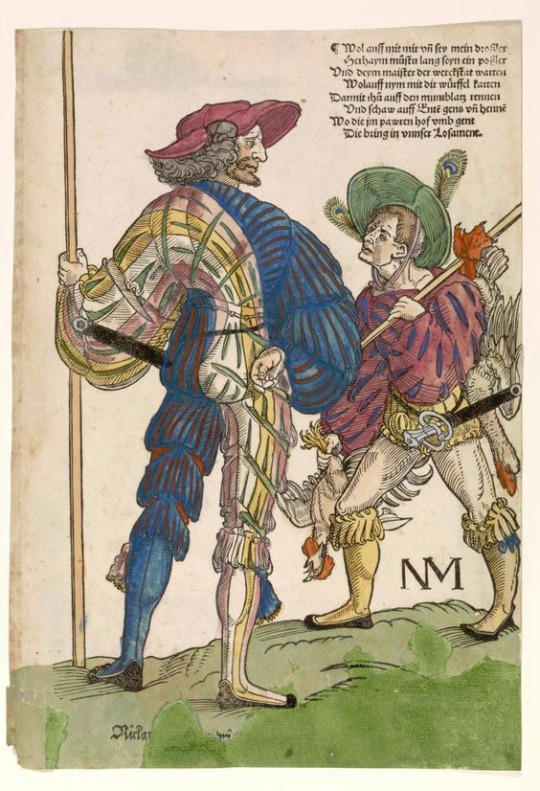
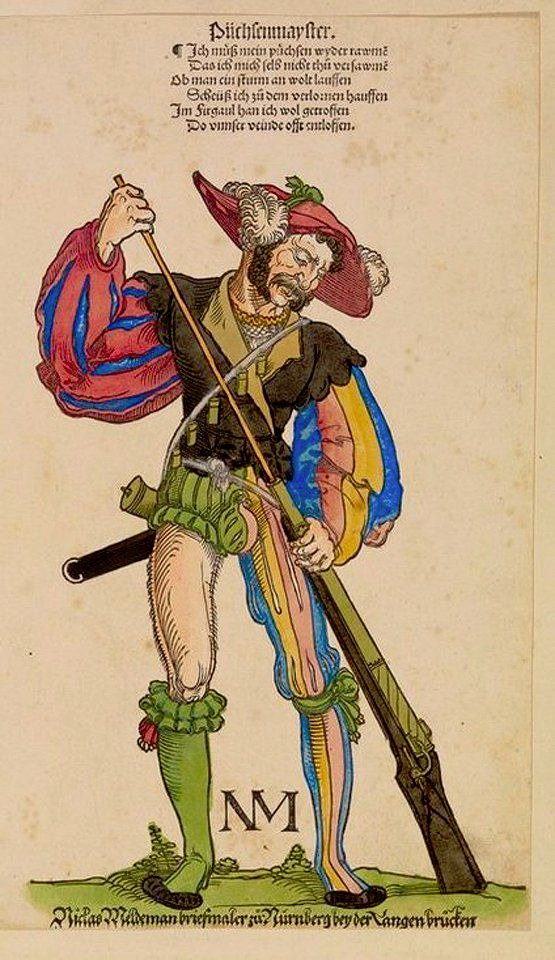
The Landsknecht were the hot shit. Their lavish and over the top influence quickly took over men's fashion in Germany in early 1500s. Slashing, the technique possibly started by them, but at least popularized by them, instantly spread all over Europe. That's how you get the typical Renaissance poof sleeves. They at first slashed the thighs of their hose, but it seems like to fit more of everything into their outfits, they started wearing the hose in two parts, upper hose and nether hose, which was a sort of return to the early Medieval trousers and knee-high hose style. The two part hose was adopted by the wider German men's fashion early in the century, but already in 1520s had spread to rest of Europe. It was first combined with the knee-length overdress that had made it's comeback in the turn of the century, like in this Italian painting from 1526 (first image). At this point knitting had become established and wide-spread craft in Europe and the stockings were born, replacing nether hose. They were basically nether hose, but from knitted fabric. The gown shortened again and turned into more of a jacket as the trunk hose became increasingly the centerpiece of the outfit, until in 1560s doublet - trunk hose combination emerged as the standard outerwear (as seen in the second example, 1569 Netherlands) putting the last nail on the coffin of the men's dress as well as the Sluttiest Era. The hose and doublet became profoundly un-slutty and un-horny, especially when the solemn Spanish influence spread all over with it's dark and muted colors.


Especially in Middle Ages, but thorough European history, trousers have been associated with soldiers. The largely accepted theory is that trousers were invented for horse riding, but in climates with cold winters, where short skirts are too cold, and long skirts are still a hazard when moving around, trousers (with or without a short skirt) are convenient for all kinds of other movement requiring activities like war. So by adopting hose as general men's clothing, men in 1500s associated masculinity with militarism. It was not a coincidence that the style came from Landsknecht. I may have been joking about them being "peak male performance", but really they were the new masculine ideals for the new age. At the time capitalism was taking form and European great powers had begun the process of violently conquering the world for money, so it's not surprising that the men, who fought for money and became rich and powerful doing so, were idealised.
Because of capitalism and increasingly centralized power, the feudal system was crumbling and with it the feudal social hierarchy. Capitalism shifted the wealth from land ownership (which feudal nobility was built upon) to capital and trade, deteriorating the hierarchy based on land. At the same time Reformation and centralized secular powers were weakening the power of the Church, wavering also the hierarchy justified by godly ordain. The ruling class was not about to give up their power, so a new social hierarchy needed to form. Through colonialism the concept of race was created and the new hierarchy was drawn from racial, gender and wealth lines. It was a long process, but it started in 1500s, and the increasing distinction between men's and women's fashions was part of drawing those lines. At the same time distinctions between white men and racialized men, as well as white women and racialized women were drawn. As in Europe up until this point, all over the world (with some exceptions) skirts were used by everyone. So when European men fully adopted the trousers, and trousers, as well as their association to military, were equated with masculinity, part of it was to emasculate racialized men, to draw distinctions.
Surprise, it was colonialism all along! Honestly if there's a societal or cultural change after Middle Ages, a good guess for the reason behind it is always colonialism. It won't be right every time, but quite a lot of times. Trousers as a concept is of course not related to colonialism, but the idea that trousers equal masculinity and especially the idea that skirts equal femininity are. So I guess decolonize masculinity by wearing skirts?
#this has been sitting in my drafts almost finished for like a year or something#historical fashion#fashion history#fashion#history#dress history#men's historical fashion#renaissance fashion#medieval fashion#western fashion#western fashion history#landsknecht
3K notes
·
View notes
Text
A Plane To Catch - Moko Jumbie - jazz/funk from Denmark
Bonded over the struggles of the pandemic and a mutual love for Motown, Soul and Afrobeat, Denmark’s renowned outlet for jazz, April Records, proudly presents ‘Moko Jumbie’, the debut by it’s latest outfit ‘A Plane To Catch’, set to release on April 28th.
The vibrant Danish jazz scene came to a crashing halt along with the rest of the world in early 2020, and a tight-knit community of up-and-coming musicians were thrust into a void, robbed of the largest part of their livelihood and joy, live performance.
Gathering in a graffiti-smudged artist's space in an old industrial facility in Copenhagen’s outskirts, they created a space for themselves to improvise in a funky, groove-based setting..
What came out was an expression of longing for all that was lost during the pandemic - a musical antidote to the loss of fun, joy, community, movement, travel and youthful abandon that the pandemic had temporarily put a halt to.
Exploring the rich exchange between West African musical traditions and Western funk and soul, this is music meant for dancing, transporting the listener to dance floors both real and imagined. Featuring warm, raw production the record creates a real sense of energy and intimacy, as if the listener is in a dark club with an electric jam band.
Through the eight compositions the quintet joyfully navigates familiar harmonic clichés from 70’s soul tunes, a variety of infectious toe-tapping grooves, playful improvisations and melodic duo horn arranging. Explorations of darker tonalites popularised by Ethio-Jazz legend Mulatu Astatke provide a welcome departure through harmonic contrast and propulsive polyrhythmic groove.
The title ‘Moko Jumbie’ derives from a mythical character in Afro-Caribbean folklore. During carnival season masked Moko Jumbies can be seen dancing on stilts in colorful garments, towering over the crowds. Part gods, part healers, part ghosts, and most importantly: moving expressions of freedom and the perfect mascot for this celebratory album.
A PLANE TO CATCH is:
Andreas Toftemark - Saxophone
Rolf Thofte – Trumpet
Mads Nørgaard - Guitar
Anton Langebæk - Bass
David Besiakov – Drums
Guests:
Simon Eskildsen – Organ (1, 3, 4, 5, 8)
Yohan Ramon – Percussion (2, 4, 5, 7, 8)
Cover Artwork by Simon Eskildsen
All compositions by Andreas Toftemark, except “Lingon Grove” by David Besiakov and Andreas Toftemark.
Published by April Publishing ApS
2 notes
·
View notes
Text
In an era of unparalleled global connectivity, international shipping stands as the lifeblood of the world economy. The movement of goods across borders has become an essential cornerstone, facilitating trade on a scale never before witnessed. This intricate dance of cargo vessels crisscrossing the oceans is not merely a logistical spectacle but a vital force shaping the economic landscape. As we delve into the complexities of international shipping, it becomes evident that its significance extends far beyond the harbors and shipping lanes. The very pulse of the global economy beats in tandem with the ebb and flow of containers across continents.Key factors influencing the economy through international shipping are multifaceted. From fostering economic interdependence among nations to driving innovation in logistics, the ramifications of this industry reverberate across sectors. The efficient movement of goods is imperative for the sustenance and growth of economies worldwide. As we navigate the nuances of international shipping, we unravel a tapestry of economic intricacies, where each thread represents a transaction, a partnership, or a venture contributing to the interconnected web of global trade.
Overview of International Shipping
At its core, international shipping encompasses the transportation of goods between countries through various modes, primarily maritime, but also air and land. Ships laden with containers traverse vast expanses of the world's oceans, serving as floating conduits of commerce. These vessels, ranging from colossal container ships to nimble freighters, facilitate the movement of raw materials, finished products, and everything in between.The scale of global shipping is staggering, with millions of tons of cargo navigating established maritime routes daily. In 2021 alone, the world's merchant fleet transported over 11 billion tons of goods, underscoring the sheer magnitude of this industry. The strategic placement of ports, the optimization of shipping routes, and the continuous evolution of containerization have revolutionized the efficiency and scope of international shipping.Consider this: approximately 80% of global trade by volume and 70% by value is transported by sea. This statistic alone attests to the pivotal role played by maritime shipping in sustaining the interconnectedness of the world's economies. The economic impact is not confined to the transportation sector; it radiates outward, influencing manufacturing, retail, and various service industries. International shipping, with its vast scope and intricate web of connections, is undeniably a linchpin in the machinery of the global economy.
Key Players in International Shipping
The realm of international shipping is navigated by a constellation of key players, major companies, and influential organizations that steer the course of global trade. Among these titans of the seas, names like Maersk, Mediterranean Shipping Company (MSC), and CMA CGM resonate prominently. Maersk, a Danish shipping giant, operates the largest container shipping fleet globally, emblematic of its colossal role in shaping the logistics landscape. MSC, headquartered in Switzerland, follows closely, commanding an extensive network of vessels that crisscross the world's oceans. French-based CMA CGM, with its innovative approach and vast fleet, further solidifies the trio at the forefront of international shipping.These companies, along with others like Evergreen Marine and Hapag-Lloyd, play pivotal roles in orchestrating the intricate ballet of containers, influencing the efficiency and reliability of global supply chains. Their contributions extend beyond the mere movement of goods; they are architects of connectivity, knitting together economies and enabling the seamless exchange of products on a global scale. Through strategic alliances, cutting-edge technologies, and a relentless commitment to operational excellence, these key players define the modern narrative of international shipping.
Economic Benefits of International Shipping
The economic benefits derived from international shipping are as vast as the oceans it traverses, permeating through the fabric of global commerce and impacting businesses and nations alike. At the heart of these advantages lies the concept of comparative advantage. Countries engage in international trade, facilitated by shipping, to capitalize on their unique strengths, be it natural resources, skilled labor, or technological prowess. This specialization enhances efficiency, fosters innovation, and propels economic growth.Businesses, particularly those engaged in export and import activities, reap the rewards of international shipping. Access to a broader market allows for increased sales and revenue, while diversified sources of inputs mitigate risks and enhance competitiveness. Small and medium-sized enterprises (SMEs), in particular, benefit from the global reach enabled by shipping, as it provides them with opportunities to scale and expand beyond domestic boundaries.Countries, too, accrue substantial advantages. International shipping fosters economic interdependence, reducing the likelihood of conflicts and promoting diplomatic relations. The influx of foreign goods stimulates local economies, creating jobs and fueling economic development. Moreover, it allows nations to tap into resources and products not readily available domestically, enriching the lives of their citizens and fostering a global community.As a testament to these benefits, consider the transformative impact of international shipping on emerging economies. Countries that actively participate in global trade experience accelerated development, with increased access to capital, technology, and knowledge.
Challenges and Concerns
While international shipping serves as the linchpin of global trade, it is not without its challenges and concerns. Navigating the complex seas of commerce brings forth a myriad of obstacles that impact the industry's efficiency and resilience. One of the foremost challenges lies in the volatility of fuel prices. The reliance on fossil fuels for propulsion exposes shipping companies to the unpredictable fluctuations in oil prices, leading to increased operational costs and, consequently, potential economic strain.The regulatory landscape presents another hurdle. The international shipping industry operates in a framework of diverse and evolving regulations, ranging from environmental standards to safety protocols. Compliance with these regulations demands substantial investments in technology and infrastructure, posing financial burdens on shipping companies. Moreover, the patchwork of regulations across different regions can create operational complexities and hinder the seamless flow of goods.Environmental sustainability is a growing concern within the industry. The carbon footprint of maritime transport raises questions about its long-term viability in the face of climate change. Pressure to reduce emissions and adopt cleaner technologies places economic burdens on companies, requiring investments in greener alternatives and potentially impacting their competitiveness.Supply chain disruptions, as witnessed during global crises such as the COVID-19 pandemic, highlight the vulnerability of international shipping to unforeseen events. From port closures to labor shortages, disruptions can ripple through the entire supply chain, causing economic repercussions for businesses and nations reliant on timely and consistent deliveries.Addressing these challenges requires a concerted effort from industry stakeholders, governments, and international bodies to ensure the continued resilience of the global shipping infrastructure.
Technological Advancements and Innovation
In the vast expanse of the world's oceans, technology is propelling international shipping into a new era of efficiency and sustainability. The integration of advanced technologies
is transforming traditional maritime practices, offering economic implications and benefits that resonate far beyond the shipping industry.Automation and artificial intelligence (AI) are revolutionizing vessel operations. Smart navigation systems, automated port operations, and predictive maintenance are enhancing efficiency, reducing human errors, and optimizing fuel consumption. These advancements not only contribute to cost savings for shipping companies but also bolster the reliability and speed of global supply chains.The adoption of blockchain technology is streamlining the complex web of transactions in international shipping. Smart contracts, transparent and tamper-proof ledgers, and improved traceability are enhancing the security and efficiency of financial and logistical processes. This, in turn, reduces the administrative burden on companies, unlocking economic value and fostering trust among stakeholders.Innovations in vessel design and propulsion are driving sustainability. From the development of eco-friendly fuels to the exploration of alternative propulsion systems, technology is helping the industry address environmental concerns. While the initial investments in these technologies may pose economic challenges, the long-term benefits include reduced environmental impact, compliance with regulatory standards, and enhanced corporate social responsibility.The synergy between technology and international shipping is not just a modernization effort; it is a strategic leap toward a more resilient, sustainable, and economically robust future for the entire global trade ecosystem.
The Canadian Perspective
In the vast tapestry of global trade, Canada stands as a key player, strategically positioned to harness the opportunities presented by international shipping. As the second-largest country in the world, endowed with abundant natural resources and a robust economy, Canada's role in international shipping is pivotal.Canadian ports, spanning both the Atlantic and Pacific coasts, serve as crucial gateways for the country's exports and imports. Ports like Vancouver, Montreal, and Halifax play a strategic role in facilitating the movement of goods, not only within North America but also as vital links in global supply chains. The country's extensive coastline, along with the St. Lawrence Seaway, offers efficient routes for maritime transportation, contributing to the seamless flow of goods worldwide.Canada's economy benefits significantly from its active participation in global trade facilitated by international shipping. The export of natural resources, including timber, minerals, and energy products, forms a substantial part of Canada's trade portfolio. Conversely, the nation imports a diverse range of goods, from machinery to consumer products, meeting domestic demands and fostering economic diversity.Moreover, Canada's commitment to sustainable practices aligns with the evolving trends in international shipping. The exploration of cleaner technologies, adherence to environmental standards, and investments in green infrastructure showcase Canada's dedication to responsible and eco-friendly trade practices.As Canada continues to navigate the dynamic landscape of international shipping, it positions itself not only as a contributor to the global trade ecosystem but also as a responsible steward of the oceans and the environment.
Future Trends and Predictions
The future of international shipping holds promise and challenges, with several trends poised to reshape the landscape and influence the global and Canadian economies. Sustainable Shipping Practices:As the world intensifies its focus on environmental sustainability, the shipping industry is expected to undergo a transformative shift toward cleaner and greener practices. The adoption of alternative fuels, the development of eco-friendly vessels, and increased emphasis on reducing carbon emissions are trends that align with Canada's commitment to environmental stewardship.
This transition may, however, entail initial economic investments for the industry, with the potential for long-term gains in terms of environmental conservation and international regulatory compliance. Digitalization and Automation:The integration of digital technologies and automation in international shipping is set to increase efficiency and reduce operational costs. From smart ports to autonomous vessels, these innovations have the potential to streamline processes and enhance the reliability of global supply chains. Canada, with its technologically advanced infrastructure, is likely to benefit from these trends, fostering economic growth and competitiveness. Evolving Trade Alliances:Shifts in geopolitical dynamics and trade alliances may impact the routes and volumes of international shipping. Canada's role in these evolving alliances, such as the Comprehensive and Progressive Agreement for Trans-Pacific Partnership (CPTPP) and the United States-Mexico-Canada Agreement (USMCA), will influence the direction of trade flows and economic partnerships. Infrastructure Investments:Anticipated growth in global trade will necessitate investments in port infrastructure and logistics. Canada's commitment to upgrading and expanding its ports and transportation networks positions the country to capitalize on increased trade volumes, contributing to economic development and job creation.In navigating these future trends, Canada has the opportunity to further solidify its position in the international shipping arena, fostering economic resilience, sustainability, and continued contributions to the interconnected web of global trade.
Explore Boundless Horizons with ShipShop
As you've delved into the intricate world of international shipping and its profound impact on the global and Canadian economy, there's no better time to embark on your own journey of discovery with ShipShop. Our commitment to seamless logistics, reliability, and sustainability positions us as your trusted partner in navigating the vast oceans of global trade.Why Choose ShipShop?Global Connectivity: Benefit from our extensive network that spans across major shipping routes, ensuring your cargo reaches its destination with precision and efficiency.Innovation and Sustainability: At ShipShop, we embrace cutting-edge technologies and eco-friendly practices. Join us in contributing to a sustainable future while enjoying the benefits of streamlined and responsible shipping solutions.Canadian Expertise: Leverage our understanding of Canada's unique position in international shipping. We are well-versed in the intricacies of Canadian trade, offering tailored solutions to meet your specific needs.Embark on a journey of reliability, innovation, and sustainability with ShipShop. Your global shipping partner awaits, ready to transform your shipping experience and propel your ventures to new heights. Choose ShipShop today and redefine the way you navigate the seas of international trade. Sign up now!
FAQ
.aed1427e-e5ff-4359-b373-334313c48315fill:#1c2448;
.e3c7dd86-9752-467e-8574-885a4e9461bbfill:#1c2448;
How does international shipping contribute to the Canadian economy?
International shipping is a cornerstone of Canada’s economic vitality. By facilitating the seamless movement of goods, it enhances trade, creates jobs, and fuels economic growth. Canadian ports serve as crucial gateways, connecting the nation to global markets and fostering economic interdependence.
.aed1427e-e5ff-4359-b373-334313c48315fill:#1c2448;
.e3c7dd86-9752-467e-8574-885a4e9461bbfill:#1c2448;
What role does sustainability play in international shipping with respect to Canada?
Sustainability is pivotal in Canada’s approach to international shipping. As environmental concerns rise, the industry is embracing eco-friendly technologies and practices. ShipShop, aligned with these princi
ples, offers responsible and sustainable shipping solutions, contributing to Canada’s commitment to a greener future.
Q & A
Visit our FAQ section to see answers to some of our most asked questions.
Frequently Asked Questions
Let's Chat
Need help? Shoot us a message or find out more about us and how we can help your business grow.
Contact Us
Shop the Best Shipping Rate with ShipShop
Sign Up for free today!
Sign Up Today
0 notes
Photo

A home knitted sweater of the kind that slovenian friends tell me were extremely popular after the split up of slovenia draped across a Lupina chair designed by **Niko Kralj, who is sometimrs called the founder of Slovenian industrial design, in the 60ies.** On the sweater plastic gold letters read "rethink the past, change the future". A variation of hip-hop back patches on jeans jackets that were so popular in early days of danish hip-hop. In those distant times before the internet, we had only indirect and occasional access to low-resolution black and white images of graffiti and breakdance, and a single tape with a few minutes of rap recorded from the Danish national radio. We did not know where to go or who to ask, but we all agreed that none of what was offered up at the local youth club or in the mainstream media was of any interest. What little we knew of hip hop offered an escape from what seemed to be an inevitable absorption into the dreary mainstream of pop culture. Our localized version of the hip-hop culture remained an imaginary, fundamentally misunderstood and now long forgotten minor version of the global hip-hop culture I later came to know. However, fashioning the everyday into something with new meaning, as we attempted to do with the jeans jackets, carries within it the seeds of an alternative future and the possibility of changing the present order of things. A forgotten and unwritten local tradition, very much in line with the historical avant-gardes. This is a connection that I hope to make visible and relevant through the Tank Hip Hop project, as a way to open up new possibilities and alternative histories. Retroavantgarde a comprehensive group exhibition based on the late avant-garde movement that unfolded in the Balkans in the 1920s, and more specifically on its communicative imprint as manifested in the two art magazines "Zenit" and "Tank". The show runs untill the 18. december 2022 at @kongegaarden amd my contribution was generously supported by the @statenskunstfond #tankhiphop #ahistorythatneverwas #Retroavantgarde #sculpture #spraypaint #graffiti #avantgarde #hiphop #alternatehistory (at Kongegaarden) https://www.instagram.com/p/Cl4ciEWssDT/?igshid=NGJjMDIxMWI=
#tankhiphop#ahistorythatneverwas#retroavantgarde#sculpture#spraypaint#graffiti#avantgarde#hiphop#alternatehistory
0 notes
Text
Anonymous asked: I have always appreciated your thoughtful views on the defence of the British monarchy, and as a university historian it’s reassuring to see someone using history to make invalubale insights to a controversial institution. I wonder what are your own thoughts on the passing of Prince Philip and what his legacy might be? Was he a gaffe prone racist and a liability to the Queen?
I know you kindly got in touch and identified yourself when you felt I was ignoring your question. I’m glad we cleared that up via DM. The truth is as I said and I’m saying here is that I had to let some time pass before I felt I could reasonably answer this question. Simply because - as you know as someone who teaches history at university - distance is good to make a sober appraisal rather than knee jerk in the moment judgements.
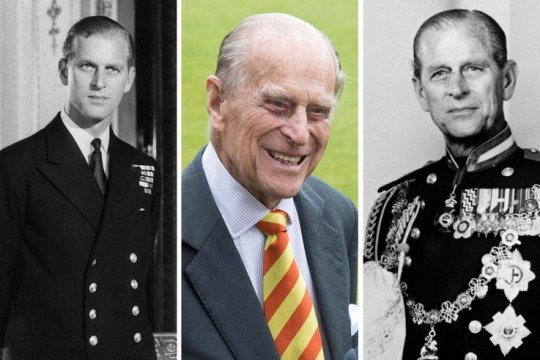
Contrary to what some might think I’m not really a fan girl when it comes to the royal family. I don’t religiously follow their every movement or utterance especially as I live in Paris and therefore I don’t really care about tabloid tittle tattle. I only get to hear of anything to do with the royal family when I speak to my parents or my great aunts and uncles for whom the subject is closer to their heart because of the services my family has rendered over past generations to the monarchy and the older (and dying) tight knit social circles they travel in.
Like Walter Bagehot, I’m more interested in the monarchy as an institution and its constitutional place within the historical, social, and political fabric of Britain and its continued delicate stabilising importance to that effect. It was Walter Bagehot, the great constitutional scholar and editor the Economist magazine, who said, “The mystic reverence, the religious allegiance, which are essential to a true monarchy, are imaginative sentiments that no legislature can manufacture in any people.” In his view, a politically-inactive monarchy served the best interests of the United Kingdom; by abstaining from direct rule, the monarch levitated above the political fray with dignity, and remained a respected personage to whom all subjects could look to as a guiding light.
Even as a staunch monarchist I freely confess that there has always been this odd nature of the relationship between hereditary monarchy and a society increasingly ambivalent about the institution. To paraphrase Bagehot again, there has been too much ‘daylight’ shone onto the ‘magic’ of the monarchy because we are obsessed with personalities as celebrities.

Having said that I did feel saddened by the passing of Prince Philip, the Duke of Edinburgh. After the Queen, he was my favourite royal. Anne, Princess Royal, would come next because she is very much like her father in temperament, humour, and character, so unlike her other brothers.
I have met the late Prince Philip when I was serving in the army in a few regimental meet-and-greet situations - which as you may know is pretty normal given that members of the royal family serve as honorary colonel-in-chiefs (patrons in effect) of all the British army regiments and corps.I also saw him at one or two social events such the annual charitable Royal Caledonian Ball (he’s an expert scottish reeler) and the Guards Polo Club where my older brothers played.
I’ll will freely confess that he was the one royal I could come close to identify with because his personal biography resonated with me a great deal.
Let’s be honest, the core Windsor family members, born to privilege, are conditioned and raised to be dull. Perhaps that’s a a tad harsh. I would prefer the term ‘anonymously self-effacing’, just another way of saying ‘for God’s sake don’t draw attention to yourself by saying or doing anything even mildly scandalous or political lest it invites public opprobrium and scrutiny’. The Queen magnificently succeeds in this but the others from Charles down just haven’t (with the exception of Princess Anne).
However, many people forget this obvious fact that it’s the incoming husbands and wives who marry into the Windsor family who are relied upon to bring colour and even liven things up a little. And long before Kate Middleton, Meghan Markle (very briefly), or Lady Diana Spencer, were the stars of ‘The Firm’- a phrase first coined by King George VI, Queen Elizabeth II's father who ruled from 1936 to 1952, who was thought to have wryly said, "British royals are 'not a family, we're a firm,” - it was Prince Philip who really livened things up and made the greater impact on the monarchy than any of them in the long term.
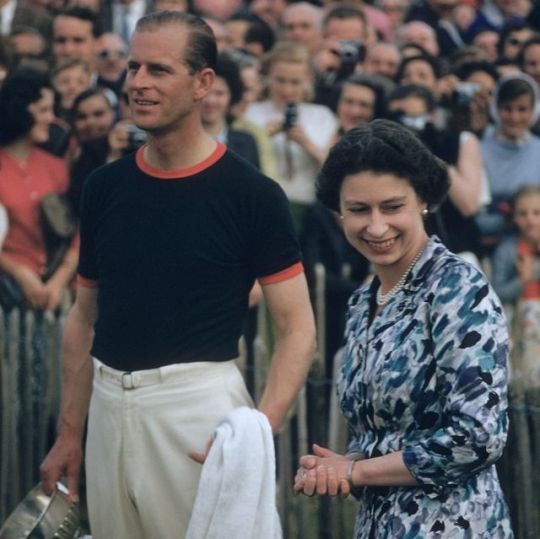
Prince Philip’s passing belied the truth of a far more complex individual: a destitute and penniless refugee Greek-Danish prince with a heart breaking backstory that could have been penned by any 19th Century novelist, and also eagle eyed reformer who tried to drag the royal family into the 20th century. At the core of the man - lost scion of a lost European royal dynasty, a courageous war veteran, and Queen’s consort - were values in which he attempted to transform and yet maintain much older inherited traditions and attitudes. Due to his great longevity, Philip’s life came to span a period of social change that is almost unprecedented, and almost no one in history viewed such a transformation from the front row.
Prince Philip would seem to represent in an acute form the best of the values of that era, which in many ways jar with today’s. He had fought with great courage in the war as a dashing young naval officer; he was regularly rude to foreigners, which was obviously a bonus to all Brits. He liked to ride and sail and shoot things. He was unsentimental almost to a comic degree, which felt reassuring at a time when a new-found emotional incontinence made many feel uncomfortable. Outrageous to some but endearing to others, he was the sort of man you’d want to go for a pint with, perhaps the ultimate compliment that an Englishman can pay to another Englishman. This has its own delicious irony as he wasn’t really an Englishman.
There are 4 takeways I would suggest in my appraisal of Prince Philip that stand out for me. So let me go through each one.
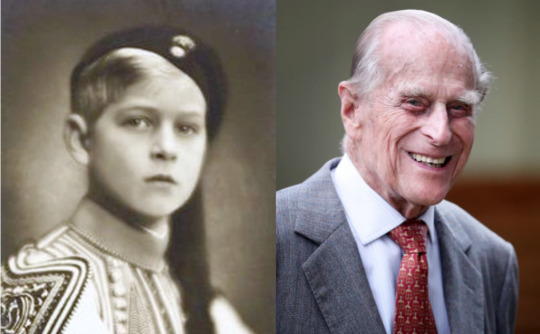
1. Prince Philip’s Internationalism
It may seem odd for me to say that Prince Philip wasn’t English but he wasn’t an Englishman in any real sense. He was a wretch of the world - stateless, homeless, and penniless. That the Prince of Nowhere became the British Monarchy’s figurehead was more than fitting for a great age of migration and transition in which the Royal Family survived and even flourished. That he was able to transform himself into the quintessential Englishman is testimony not just to his personal determination but also to the powerful cultural pull of Britishness.
He was born on a kitchen table in Corfu in June 1921. A year later in 1922, Philip, as the the great-great-grandson of Queen Victoria and nephew of Constantine I of Greece, was forced to flee with his family after the abdication of Constantine. He grew up outside Paris speaking French; ethnically he was mostly German although he considered himself Danish, his family originating from the Schleswig border region. He was in effect, despite his demeanour of Royal Navy officer briskness, a citizen of nowhere in an age of movement. From a very young age he was a stateless person, nationally homeless. Indeed, Philip was an outsider in a way that even Meghan Markle could never be; at his wedding in 1947, his three surviving sisters and two brothers-in-law were not permitted to attend because they were literally Britain’s enemies, having fought for the Germans. A third brother-in-law had even been in the SS, working directly for Himmler, but had been killed in the conflict.

Even his religion was slightly exotic. He was Greek Orthodox until he converted to Anglicanism on marrying Elizabeth - what with his wife due to become supreme head of the Church and everything - but his ties with eastern Christianity remained. His great-aunts Princess Elisabeth of Hesse and by Rhine and Tsarina Alexandra are both martyrs of the Russian Orthodox Church, having been murdered by the Bolsheviks; Philip’s mother went on to become an Orthodox nun and a “Righteous Among the Nations” for saving a Jewish family during the Nazi occupation of Greece, spending much of her time in squalid poverty.
His parents were part of the largely German extended aristocracy who ruled almost all of Europe before it all came crashing down in 1918. When he died, aged 99, it marked a near-century in which all the great ideological struggles had been and gone; he had been born before the Soviet Union but outlived the Cold War, the War on Terror and - almost - Covid-19.
The world that Philip was born into was a far more violent and dangerous place than ours. In the year he was born, Irish rebels were still fighting Black and Tans; over the course of 12 months the Spanish and Japanese prime ministers were assassinated, there was a coup in Portugal and race riots in the United States. Germany was rocked by violence from the far-Left and far-Right, while in Italy a brutal new political movement, the Fascists, secured 30 seats in parliament, led by a trashy journalist called Benito Mussolini.
The worst violence, however, took place in Greece and Turkey. Following the defeat of the Ottoman Empire, what remained of Turkey was marked for permanent enfeeblement by the Allies. But much to everyone’s surprise the country’s force were roused by the brilliant officer Mustafa Kemal, who led the Turks to victory. Constantinople was lost to Christendom for good and thousands of years of Hellenic culture was put to the flames in Smyrna.
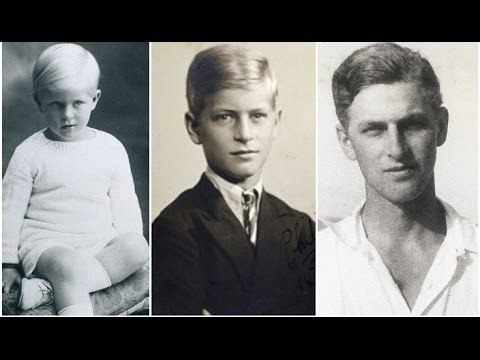
The Greek royal family, north German imports shipped in during the 19th century, bore much of the popular anger for this disaster. King Constantine fled to Italy, and his brother Andrew was arrested and only escaped execution through the intervention of his relative Britain’s George V. Andrew’s wife Alice, their four daughters and infant son Philip fled to France, completely impoverished but with the one possession that ensures that aristocrats are never truly poor: connections.
Philip had a traumatic childhood. He was forged by the turmoil of his first decade and then moulded by his schooling. His early years were spent wandering, as his place of birth ejected him, his family disintegrated and he moved from country to country, none of them ever his own. When he was just a year old, he and his family were scooped up by a British destroyer from his home on the Greek island of Corfu after his father had been condemned to death. They were deposited in Italy. One of Philip's first international journeys was spent crawling around on the floor of the train from an Italian port city, "the grubby child on the desolate train pulling out of the Brindisi night," as his older sister Sophia later described it.

In Paris, he lived in a house borrowed from a relative; but it was not destined to become a home. In just one year, while he was at boarding school in Britain, the mental health of his mother, Princess Alice, deteriorated and she went into an asylum; his father, Prince Andrew, went off to Monte Carlo to live with his mistress. "I don't think anybody thinks I had a father," he once said. Andrew would die during the war. Philip went to Monte Carlo to pick up his father's possessions after the Germans had been driven from France; there was almost nothing left, just a couple of clothes brushes and some cuff-links.
Philip’s four sisters were all much older, and were soon all married to German aristocrats (the youngest would soon die in an aeroplane crash, along with her husband and children). His sisters became ever more embroiled in the German regime. In Scotland going to Gordonstoun boarding school, Philip went the opposite direction, becoming ever more British. Following the death of his sister Cecilie in a plane crash in 1937, the gulf widened. As the clouds of conflict gathered, the family simply disintegrated. With a flash of the flinty stoicism that many would later interpret, with no little justification, as self-reliance to the point of dispassion, the prince explained: “It’s simply what happened. The family broke up… I just had to get on with it. You do. One does.”
In the space of 10 years he had gone from a prince of Greece to a wandering, homeless, and virtually penniless boy with no-one to care for him. He got through it by making a joke of everything, and by being practical.
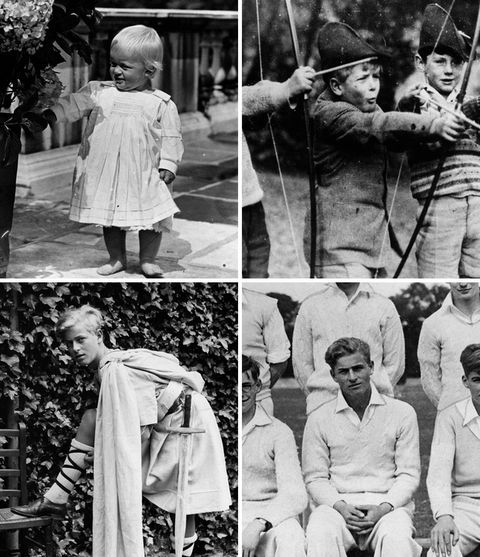
By the time he went to Gordonstoun, a private boarding school on the north coast of Scotland, Philip was tough, independent and able to fend for himself; he'd had to be. Gordonstoun would channel those traits into the school's distinct philosophy of community service, teamwork, responsibility and respect for the individual. And it sparked one of the great passions of Philip's life - his love of the sea. It was Gordonstoun that nurtured that love through the maturation of his character.
Philip adored the school as much as his son Charles would despise it. Not just because the stress it put on physical as well as mental excellence - he was a great sportsman. But because of its ethos, laid down by its founder Kurt Hahn, a Jewish exile from Nazi Germany.
Hahn first met Philip as a boy in Nazi Germany. Through a connection via one of his sister’s husbands, Philip, the poor, lonely boy was first sent off to a new school - in Nazi Germany. Which was as fun as can be imagined. Schloss Salem had been co-founded by stern educator called Kurt Hahn, a tough, discipline-obsessed conservative nationalist who saw civilisation in inexorable decline. But by this stage Hahn, persecuted for being Jewish in Nazi Germany, had fled to Britain, and Philip did not spend long at the school either, where pressure from the authorities was already making things difficult for the teachers. Philip laughed at the Nazis at first, because their salute was the same gesture the boys at his previous school had to make when they wanted to go to the toilet, but within a year he was back in England, a refugee once again.
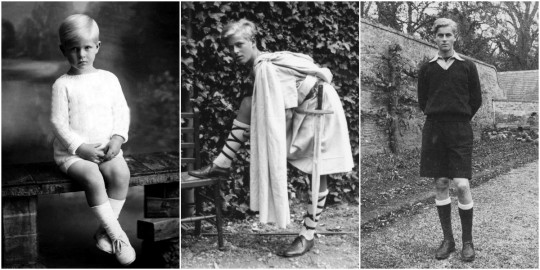
Philip happily attended Hahn’s new school, Gordonstoun, which the strict disciplinarian had set up in the Scottish Highlands. Inspired by Ancient Sparta, the boys (and then later girls) had to run around barefoot and endure cold showers, even in winter, the whole aim of which was to drive away the inevitable civilisational decay Hahn saw all around him. To 21st century ears it sounds like hell on earth, yet Philip enjoyed it, illustrating just what a totally alien world he came from.
That ethos became a significant, perhaps the significant, part of the way that Philip believed life should be lived. It shines through the speeches he gave later in his life. "The essence of freedom," he would say in Ghana in 1958, "is discipline and self-control." The comforts of the post-war era, he told the British Schools Exploring Society a year earlier, may be important "but it is much more important that the human spirit should not be stifled by easy living". And two years before that, he spoke to the boys of Ipswich School of the moral as well as material imperatives of life, with the "importance of the individual" as the "guiding principle of our society".
It was at Gordonstoun one of the great contradictions of Philip's fascinating life was born. The importance of the individual was what in Kurt Hahn's eyes differentiated Britain and liberal democracies from the kind of totalitarian dictatorship that he had fled. Philip put that centrality of the individual, and individual agency - the ability we have as humans to make our own moral and ethical decisions - at the heart of his philosophy.

At Dartmouth Naval College in 1939, the two great passions of his life would collide. He had learned to sail at Gordonstoun; he would learn to lead at Dartmouth. And his driving desire to achieve, and to win, would shine through. Despite entering the college far later than most other cadets, he would graduate top of his class in 1940. In further training at Portsmouth, he gained the top grade in four out of five sections of the exam. He became one of the youngest first lieutenants in the Royal Navy.
The navy ran deep in his family. His maternal grandfather had been the First Sea Lord, the commander of the Royal Navy; his uncle, "Dickie" Mountbatten, had command of a destroyer while Philip was in training. In war, he showed not only bravery but guile. It was his natural milieu. "Prince Philip", wrote Gordonstoun headmaster Kurt Hahn admiringly, "will make his mark in any profession where he will have to prove himself in a trial of strength".
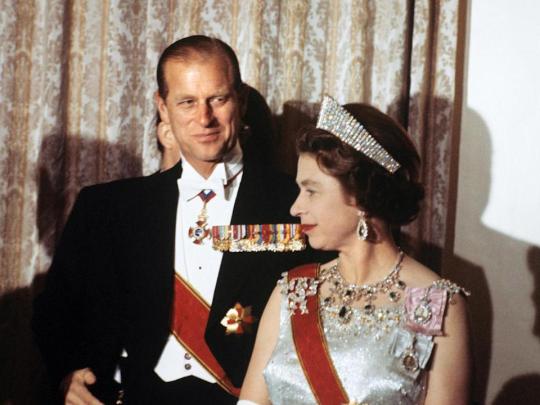
2. Prince Philip and the modernisation of the monarchy
In his own words, the process of defining what it meant to be a royal consort was one of “trial and error.” Speaking with BBC One’s Fiona Bruce in 2011, Philip explained, “There was no precedent. If I asked somebody, 'What do you expect me to do?' they all looked blank. They had no bloody idea, nobody had much idea.” So he forged for himself a role as a moderniser of the monarchy.
He could not have had much idea back in 1939. Back then in Dartmouth in 1939, as war became ever more certain, the navy was his destiny. He had fallen in love with the sea itself. "It is an extraordinary master or mistress," he would say later, "it has such extraordinary moods." But a rival to the sea would come.
When King George VI toured Dartmouth Naval College, accompanied by Philip's uncle, he brought with him his daughter, Princess Elizabeth. Philip was asked to look after her. He showed off to her, vaulting the nets of the tennis court in the grounds of the college. He was confident, outgoing, strikingly handsome, of royal blood if without a throne. She was beautiful, a little sheltered, a little serious, and very smitten by Philip.
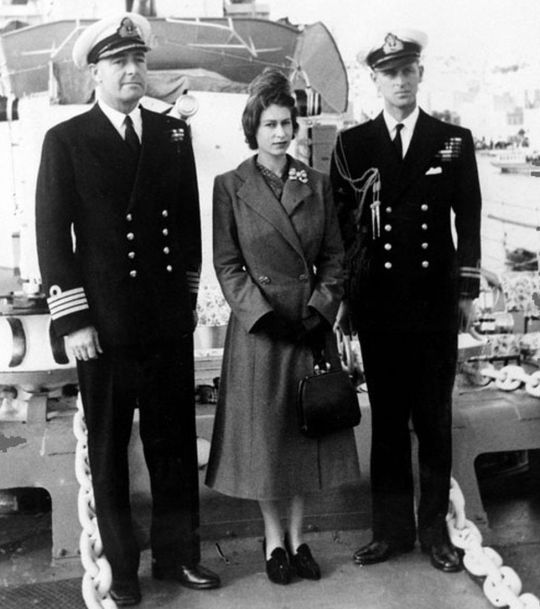
Did he know then that this was a collision of two great passions? That he could not have the sea and the beautiful young woman? For a time after their wedding in 1948, he did have both. As young newlyweds in Malta, he had what he so prized - command of a ship - and they had two idyllic years together. But the illness and then early death of King George VI brought it all to an end.
He knew what it meant, the moment he was told. Up in a lodge in Kenya, touring Africa, with Princess Elizabeth in place of the King, Philip was told first of the monarch's death in February 1952. He looked, said his equerry Mike Parker, "as if a ton of bricks had fallen on him". For some time he sat, slumped in a chair, a newspaper covering his head and chest. His princess had become the Queen. His world had changed irrevocably.
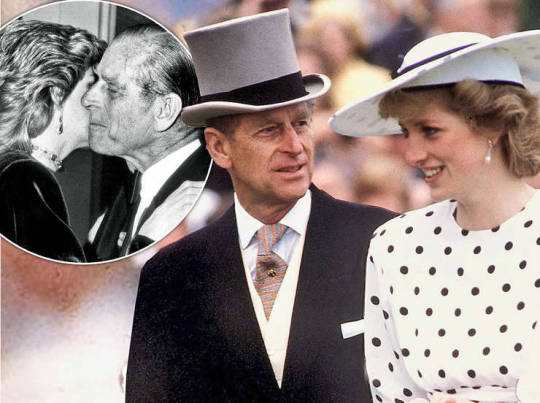
While the late Princess Diana was later to famously claim that there were “three people” in her marriage - herself, Prince Charles and Camilla - there were at least 55 million in Philip and Elizabeth’s. As Elizabeth dedicated her life to her people at Westminster Abbey at the Coronation on June 2, 1953, it sparked something of an existential crisis in Philip. Many people even after his death have never really understood this pivotal moment in Philip’s life. All his dreams of being a naval officer and a life at sea as well as being the primary provider and partner in his marriage were now sacrificed on the altar of duty and love.
With his career was now over, and he was now destined to become the spare part. Philip, very reasonably, asked that his future children and indeed his family be known by his name, Mountbatten. In effect he was asking to change the royal family’s name from the House of Windsor to the House of Mountbatten. But when Prime Minister Winston Churchill got wind of it as well as the more politically agile courtiers behind the Queen, a prolonged battle of wits ensued, and it was one Philip ultimately lost. It was only in 1957 that he accepted the title of “Prince.”
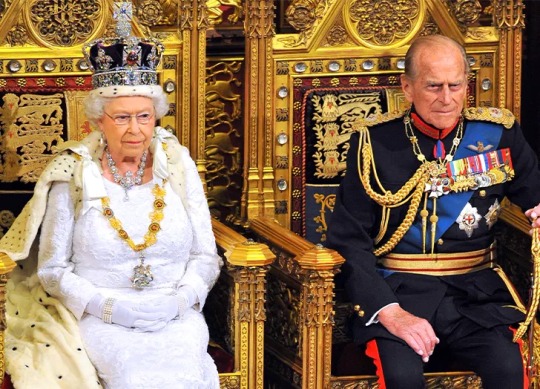
Even though he had almost lost everything dear to him and his role now undefined, he didn’t throw himself a pity party. He just got on with it. Philip tried to forge his own distinct role as second fiddle to the woman who had come to represent Great Britain. He designated himself the First Officer of the Good Ship Windsor. He set about dusting off some of the cobwebs off the throne and letting some daylight unto the workings of the monarchy by advocating reasonable amount of modernisation of the monarchy.
He had ideas about modernising the royal family that might be called “improving optics” today. But in his heart of hearts he didn’t want the monarchy to become a stuffy museum piece. He envisaged a less stuffy and more popular monarchy, relevant to the lives of ordinary people. Progress was always going to be incremental as he had sturdy opposition from the old guard who wanted to keep everything as it was, but nevertheless his stubborn energy resulted in significant changes.
When a commission chaired by Prince Philip proposed broadcasting the 1953 investiture ceremony that formally named Elizabeth II as queen on live television, Prime Minister Winston Churchill reacted with outright horror, declaring, “It would be unfitting that the whole ceremony should be presented as if it were a theatrical performance.” Though the queen had initially voiced similar concerns, she eventually came around to the idea, allowing the broadcast of all but one segment of the coronation. Ultimately, according to the BBC, more than 20 million people tuned in to the televised ceremony - a credit to the foresight of Philip.
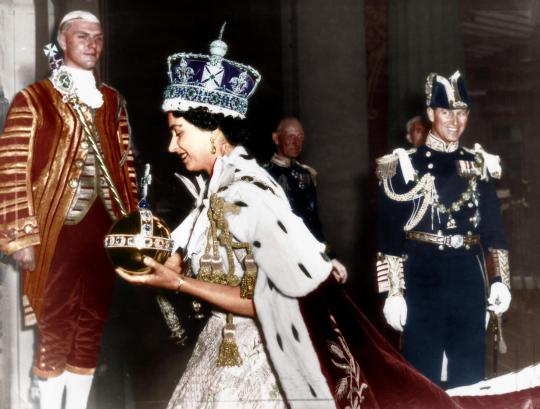
Elizabeth’s coronation marked a watershed moment for a monarchy that has, historically, been very hands off, old-fashioned and slightly invisible. Over the following years, the royals continued to embrace television as a way of connecting with the British people: In 1957, the queen delivered her annual Christmas address during a live broadcast. Again, this was Philip’s doing when he cajoled the Queen to televise her message live. He even helped her in how to use the teleprompter to get over her nerves and be herself on screen.
Four years later, in 1961, Philip became the first family member to sit for a television interview. It is hard for us to imagine now but back then it was huge. For many it was a significant step in modernising the monarchy.
Though not everything went to plan. Toward the end of the decade, the Windsors even invited cameras into their home. A 1969 BBC fly-on-the-wall documentary, instigated by Philip to show life behind the scenes, turned into an unmitigated disaster: “The Windsors” revealed the royals to be a fairly normal, if very rich, British upper-class family who liked barbecues, ice cream, watching television and bickering. The mystery of royalty took a hit below the waterline from their own torpedo, a self-inflicted wound from which they took a long time to recover. Shown once, the documentary was never aired again. But it had an irreversible effect, and not just by revealing the royals to be ordinary. By allowing the cameras in, Philip opened the lid to the prying eyes of the paparazzi who could legitimately argue that since the Royals themselves had sanctioned exposure, anything went. From then on, minor members of the House of Windsor were picked off by the press, like helpless tethered animals on a hunting safari.
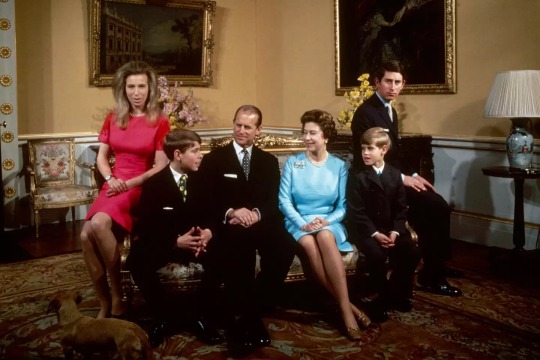
Prince Philip also took steps to reorganise and renovate the royal estates in Sandringham and Balmoral such as intercoms, modern dish washers, generally sought to make the royal household and the monarchy less stuffy, not to have so much formality everywhere.
Philip helped modernised the monarchy in other ways to acknowledge that the monarchy could be responsive to changes in society. It was Prince Philip - much to the chagrin of the haughty Princess Margaret and other stuffy old courtiers - who persuaded the Queen to host informal lunches and garden parties designed to engage a broader swath of the British public. Conversely, Prince Philip heartily encouraged the Queen (she was all for it apparently but was still finding her feet as a new monarch) to end the traditional practice of presenting debutantes from aristocratic backgrounds at court in 1952. For Philip and others it felt antiquated and out of touch with society. I know in speaking to my grandmother and others in her generation the decision was received with disbelief at how this foreign penniless upstart could come and stomp on the dreams of mothers left to clutch their pearls at the prospect there would be no shop window for their daughter to attract a suitable gentleman for marriage. One of my great aunts was over the moon happy that she never would have to go through what she saw as a very silly ceremony because she preferred her muddy wellies to high heels.

A former senior member of the royal household, who spent several years working as one of Prince Philip’s aides, and an old family friend, once told us around a family dinner table that the Duke of Edinburgh was undoubtedly given a sense of permanence by his marriage into the Royal Family that was missing from earlier years. But the royal aide would hastily add that Prince Philip, of course, would never see it that way.
Prince Philip’s attitude was to never brood on things or seek excuses. And he did indeed get on with the job in his own way - there should be no doubt that when it came to building and strengthening the Royal Family it was a partnership of equals with the Queen. Indeed contrary to Netflix’s hugely popular series ‘The Crown’ and its depiction of the royal marriage with Philip’s resentment at playing second fiddle, the prince recognised that his “first duty was to serve the Queen in the best way I could,” as he told ITV in 2011. Though this role was somewhat ill-suited to his dynamic, driven, and outspoken temperament, Philip performed it with utter devotion.
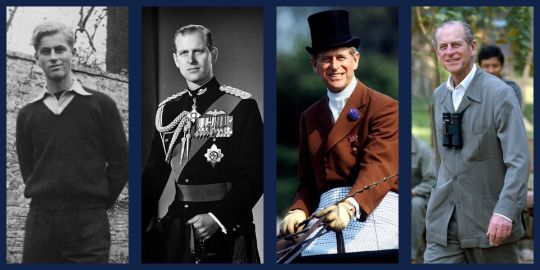
3. Prince Philip’s legacy
One could argue rightly that modernising the monarchy was his lasting legacy achievement. But he also tried to modernise a spent and exhausted Britain as it emerged from a ruinous war. When peace came, and with it eventual economic recovery, Philip would throw himself into the construction of a better Britain, urging the country to adopt scientific methods, embracing the ideas of industrial design, planning, education and training. A decade before Harold Wilson talked of the "white heat of the technological revolution", Philip was urging modernity on the nation in speeches and interviews. He was on top of his reading of the latest scientific breakthroughs and well read in break out innovations.
This interest in modernisation was only matched by his love for nature. As the country and the world became richer and consumed ever more, Philip warned of the impact on the environment, well before it was even vaguely fashionable. As president of the World Wildlife Fund (WWF) in the UK for more than 20 years from 1961, he was one of the first high-profile advocates of the cause of conservation and biological diversity at a time when it was considered the preserve of an eccentric few.
For a generation of school children in Britain and the Commonwealth though, his most lasting legacy and achievement will be the Duke of Edinburgh Awards (DofE). He set up the Duke of Edinburgh award, a scheme aimed at getting young people out into nature in search of adventure or be of service to their communities. It was a scheme that could match the legacy of Baden Powell’s scouts movement.
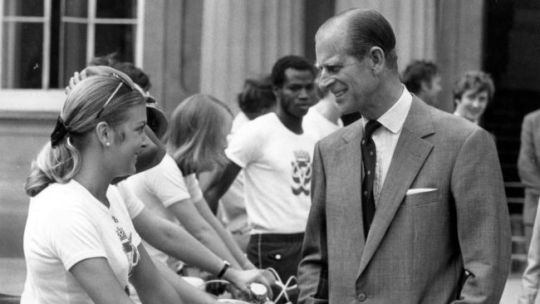
When Prince Philip first outlined his idea of a scheme to harness the values of his education at Gordonstoun by bringing character-building outdoor pursuits to the many rather than the fee-paying few, he received short shrift from the government of the day. The then minister of education, Sir David Eccles responded to the Duke’s proposal by saying: “I hear you’re trying to invent something like the Hitler Youth.” Undeterred he pushed on until it came to fruition.
I’m so glad that he did. I remember how proud I was for getting my DofE Awards while I was at boarding school. With the support of great mentors I managed to achieve my goals: collecting second-hand English books for a literacy programme for orphaned street children in Delhi, India with a close Indian school friend and her family; and completing a 350 mile hike following St. Olav’s Pilgrimmage Trail from Selånger, on the east coast of Sweden, and ending at Nidaros Cathedral in Trondheim, on the west coast of Norway.
It continues to be an enduring legacy. Since its launch in 1956, the Duke of Edinburgh awards have been bestowed upon some 2.5 million youngsters in Britain and some eight million worldwide. For a man who once referred to himself as a “Greek princeling of no consequence”, his pioneering tutelage of these two organisations (alongside some 778 other organisations of which he was either president or a patron) would be sufficient legacy for most.

4. Prince Philip’s character
It may surprise some but what I liked most about Prince Philip was the very thing that helped him achieve so much and leave a lasting legacy: his character.
It is unhelpful to the caricature of Prince Philip as an unwavering but pugnacious consort whose chief talent was a dizzying facility in off-colour one-liners that he was widely read and probably the cleverest member of his family.
His private library at Windsor consists of 11,000 tomes, among them 200 volumes of poetry. He was a fan of Jung, TS Eliot, Shakespeare and the cookery writer Elizabeth David. As well as a lifelong fascination with science, technology and sport, he spoke fairly fluent French, painted and wrote a well received book on birds. It’s maddening to think how many underestimated his genuine intellect and how cultured he was behind the crusty exterior.
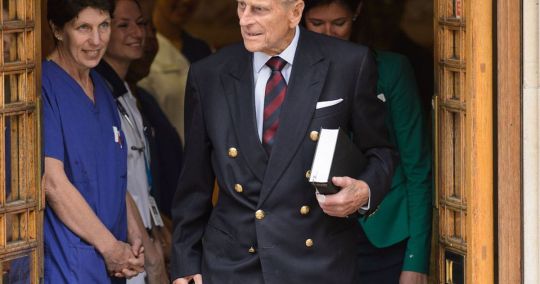
He didn’t have an entourage to fawn around him. He was the first to own a computer at Buckingham Palace. He answered his own phone and wrote and responded to his own correspondence. By force of character he fought the old guard courtiers at every turn to modernise the monarchy against their stubborn resistance.
Prince Philip was never given to self-analysis or reflection on the past. Various television interviewers tried without success to coerce him in to commenting on his legacy.But once when his guard was down he asked on the occasion of his 90th birthday what he was more proud of, he replied with characteristic bluntness: “I couldn’t care less. Who cares what I think about it, I mean it’s ridiculous.”
All of which neatly raises the profound aversion to fuss and the proclivity for tetchiness often expressed in withering put-downs that, for better or worse, will be the reflex memory for many of the Duke of Edinburgh. If character is a two edged sword so what of his gaffes?
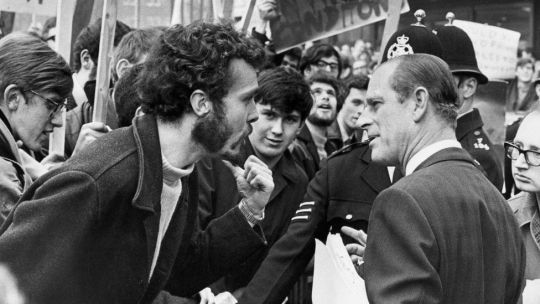
There is no doubt his cult status partly owed to his so-called legendary gaffes, of which there are enough to fill a book (indeed there is a book). But he was no racist. None of the Commonwealth people or foreign heads of state ever said this about him. Only leftist republicans with too much Twitter time on their hands screamed such a ridiculous accusation. They’re just overly sensitive snowflakes and being devoid of any humour they’re easily triggered.
There was the time that Philip accepted a gift from a local in Kenya, telling her she was a kind woman, and then adding: “You are a woman, aren’t you?” Or the occasion he remarked “You managed not to get eaten, then?” to a student trekking in Papua New Guinea. Then there was his World Wildlife Fund speech in 1986, when he said: “If it has got four legs and it is not a chair, if it has got two wings and it flies but is not an aeroplane, and if it swims and it is not a submarine, the Cantonese will eat it.” Well, he wasn’t wrong.

Philip quickly developed a reputation for what he once defined, to the General Dental Council, as “dentopedology – the science of opening your mouth and putting your foot in it”. Clearly he could laugh at himself as he often did as an ice breaker to put others at ease.
His remarking to the president of Nigeria, who was wearing national dress, “You look like you’re ready for bed”, or advising British students in China not to stay too long or they would end up with “slitty eyes”, is probably best written off as ill-judged humour. Telling a photographer to “just take the fucking picture” or declaring “this thing open, whatever it is”, were expressions of exasperation or weariness with which anyone might sympathise.
Above all, he was also capable of genuine if earthy wit, saying of his horse-loving daughter Princess Anne: “If it doesn’t fart or eat hay she isn’t interested.” Many people might have thought it but few dared say it. If Prince Philip’s famous gaffes provoked as much amusement as anger, it was precisely because they seem to give voice to the bewilderment and pent-up frustrations with which many people viewed the ever-changing modern world.

A former royal protection officer recounts how while on night duty guarding a visiting Queen and consort, he engaged in conversation with colleagues on a passing patrol. It was 2am and the officer had understood the royal couple to be staying elsewhere in the building until a window above his head was abruptly slammed open and an irate Prince Philip stuck his head out of the window to shout: “Would you fuck off!” Without another word, he then shut the window.
The Duke at least recognised from an early age that he was possessed of an abruptness that could all too easily cross the line from the refreshingly salty to crass effrontery.
One of his most perceptive biographers, Philip Eade, recounted how at the age of 21 the prince wrote a letter to a relation whose son had recently been killed in combat. He wrote: “I know you will never think much of me. I am rude and unmannerly and I say things out of turn which I realise afterwards must have hurt someone. Then I am filled with remorse and I try to put matters right.”
In the case of the royal protection officer, the Duke turned up in the room used by the police officers when off duty and said: “Terribly sorry about last night, wasn’t quite feeling myself.”
Aides have also ventured to explain away some of their employer’s more outlandish remarks - from asking Cayman islanders “You are descended from pirates aren’t you?” to enquiring of a female fashion writer if she was wearing mink knickers - as the price of his instinctive desire to prick the pomposity of his presence with a quip to put others at ease.
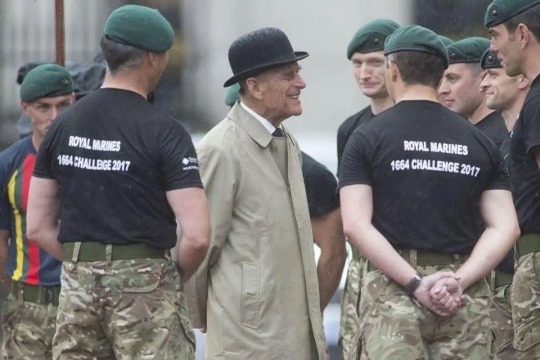
Indeed many people forget that his ‘gaffes’ were more typical of the clubbish humour of the British officer class – which of course would be less appreciated, sometimes even offensive, to other ears. It’s why he could relate so well to veterans who enjoyed his bonhomie company immensely.
But behind the irascibility, some have argued there also lay a darker nature, unpleasantly distilled in his flinty attitude to his eldest son. One anecdote tells of how, in the aftermath of the murder of the Duke’s uncle and surrogate father, Lord Mountbatten, Philip lectured his son, who was also extremely fond of his “honorary grandfather”, that he was not to succumb to self-pity. Charles left the room in tears and when his father was asked why he had spoken to his son with so little compassion, the Duke replied: “Because if there’s any crying to be done I want it to happen within this house, in front of his family, not in public. He must be toughened up, right now.”
But here I would say that Prince Philip’s intentions were almost always sincere and in no way cruel. He has always tried to protect his family - even from their own worst selves or from those outside the family ‘firm’ who may not have their best interest at heart.

In 1937, a 16-year-old Prince Philip had walked behind his elder sister Cecile’s coffin after she was killed in a plane crash while heavily pregnant. The remains of newly-born infant found in the wreckage suggested the aircraft had perished as the pilot sought to make an emergency landing in fog as the mother entered childbirth. It was an excruciating taste of tragedy which would one day manifest itself in a very princely form of kindness that was deep down that defined Philip’s character.
When about 60 years later Prime Minister Tony Blair’s spin doctors in Downing Street tried to strong arm the Queen and the royal household over the the arrangements for the late Prince Diana’s funeral, it was Philip who stepped in front to protect his family. The Prime Minister and his media savvy spin doctors wanted the two young princes, William and Harry, to walk behind the coffin.
The infamous exchange was on the phone during a conference call between London and Balmoral, and the emotional Philip was reportedly backed by the Queen. The call was witnessed by Anji Hunter, who worked for Mr Blair. She said how surprised she was to hear Prince Philip’s emotion. ‘It’s about the boys,” he cried, “They’ve lost their mother”. Hunter thought to herself, “My God, there’s a bit of suffering going on up there”.’
Sky TV political commentator Adam Boulton (Anji Hunter’s husband) would write in his book Tony’s Ten Years: ‘The Queen relished the moment when Philip bellowed over the speakerphone from Balmoral, “Fuck off. We are talking about two boys who have just lost their mother”. Boulton goes on to say that Philip: ‘…was trying to remind everyone that human feelings were involved. No 10 were trying to help the Royals present things in the best way, but may have seemed insensitive.’

In the end the politicians almost didn’t get their way. Prince Philip stepped in to counsel his grandson, Prince William, after he had expressed a reluctance to follow his mother’s coffin after her death in Paris. Philip told the grieving child: “If you don’t walk, I think you’ll regret it later. If I walk, will you walk with me?”
It’s no wonder he was sought as a counsellor by other senior royals and especially close to his grandchildren, for whom he was a firm favourite. His relationship with Harry was said to have become strained, however, following the younger Prince’s decision to reject his royal inheritance for a life away from the public eye in America with his new American wife, Meghan Markle. For Prince Philip I am quite sure it went against all the elder Prince had lived his life by - self-sacrifice for the greater cause of royalty.
This is the key to Philip’s character and in understanding the man. The ingrained habits of a lifetime of duty and service in one form or another were never far away.
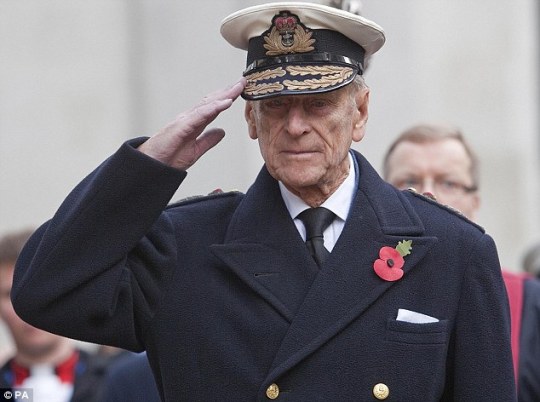
In conclusion then....
After more time passes I am sure historians will make a richer reassessment of Prince Philip’s life and legacy. Because Prince Philip was an extraordinary man who lived an extraordinary life; a life intimately connected with the sweeping changes of our turbulent 20th Century, a life of fascinating contrast and contradiction, of service and some degree of solitude. A complex, clever, eternally restless man that not even the suffocating protocols of royalty and tradition could bind him.
Although he fully accepted the limitations of public royal service, he did not see this as any reason for passive self-abnegation, but actively, if ironically, identified with his potentially undignified role. It is this bold and humorous embrace of fated restriction which many now find irksome: one is no longer supposed to mix public performance with private self-expression in quite this manner.
Yet such a mix is authentically Socratic: the proof that the doing of one’s duty can also be the way of self-fulfilment. The Duke’s sacrifice of career to romance and ceremonial office is all the more impressive for his not hiding some annoyance. The combination of his restless temperament and his deeply felt devotion to duty found fruitful expression; for instance, in the work of Saint George’s House Windsor - a centre and retreat that he created with Revd. Robin Woods - in exploring religious faith, philosophy, and contemporary issues.
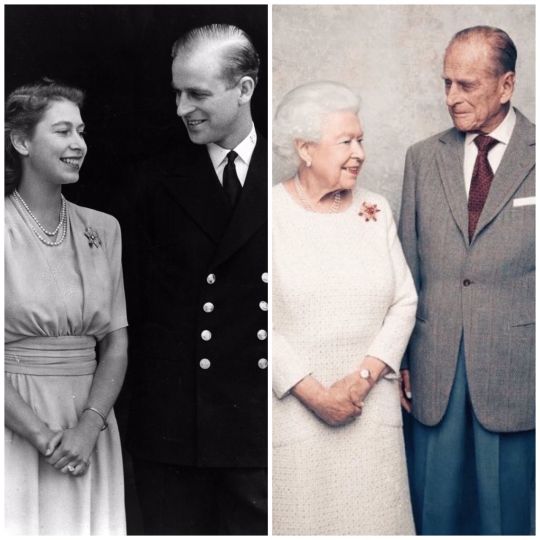
Above all he developed a way to be male that was both traditional and modern. He served one woman with chivalric devotion as his main task in life while fulfilling his public engagements in a bold and active spirit. He eventually embraced the opportunity to read and contemplate more. And yet, he remained loyal to the imperatives of his mentor Kurt Hahn in seeking to combine imagination with action and religious devotion with practical involvement.
Prince Philip took more pride in the roles he had accidentally inherited than in the personal gifts which he was never able fully to develop. He put companionship before self-realisation and acceptance of a sacred symbolic destiny before the mere influencing of events. In all these respects he implicitly rebuked our prevailing meritocracy which over-values officially accredited attainment, and our prevailing narcissism which valorises the assertion of discrete identities.
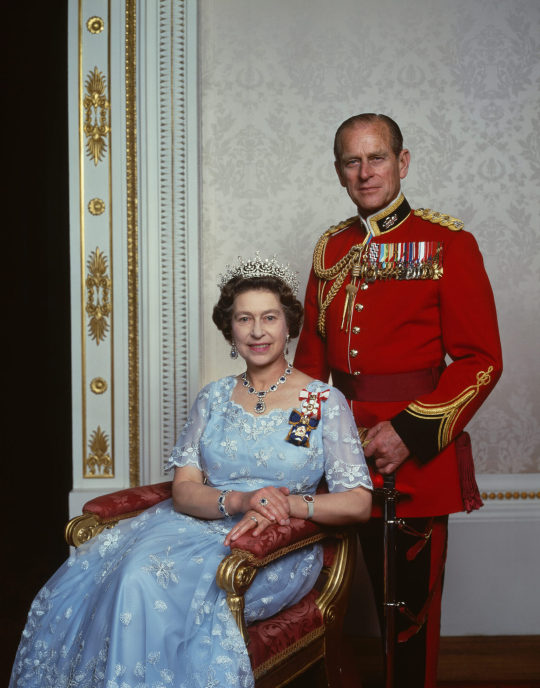
Prince Philip was Britain’s longest-serving consort. He was steadfast, duty driven, and a necessary adjunct to the continuity and stability of the Queen and the monarchy. Of all the institutions that have lost the faith of the British public in this period - the Church, Parliament, the media, the police - the Monarchy itself has surprisingly done better than most at surviving, curiously well-adapted to a period of societal change and moral anarchy. The House of Hanover and later Saxe-Coburg and Gotha (changed to Windsor), since their arrival in this country in 1714, have been noted above all for their ability to adapt. And just as they survived the Victorian age by transforming themselves into the bourgeoise, domestic ideal, so they have survived the new Elizabethan era (Harry-Meghan saga is just a passing blip like the Edward-Wallis Simpson saga of the 1930s).
There was once a time when the Royal’s German blood was a punchline for crude and xenophobic satirists. Now it is the royals who are deeply British while the country itself is increasingly cosmopolitan and globalised. British society has seen a greater demographic change than the preceding four or five thousand years combined, the second Elizabethan age has been characterised more than anything by a transformational movement of people. Prince Philip, the Greek-born, Danish-German persecuted and destitute wanderer who came to become one of the Greatest Britons of the past century, perhaps epitomised that era better than anyone else. And he got through it by making a joke of everything, and by being practical.
I hope I don’t exaggerate when I say that in our troubled times over identity, and our place and purpose in the world, we need to heed his selfless example more than ever.

As Heraclitus wisely said, Ήθος ανθρώπω δαίμων (Character is destiny.)
RIP Prince Philip. You were my prince. God damn you, I miss you already.
Thanks for your question.
#question#ask#prince philip#duke of edinburgh#queen elizabeth II#the queen of spades#monarchy#britain#british#royalty#politics#history#culture#europe#crown#icon#great briton#society
284 notes
·
View notes
Text
In Your Bright Blue Eyes - Part 2

Part 1
This is especially for @vikingalexthedane who has been absolutely wonderful with her feedback and encouraged me to keep going with this.
Original idea goes to @squirrelacorngliterfarts whose fic See You Tomorrow is absolutely sweet and heart warming.
pairing: Alex Hogh Andersen x OC
warnings: none in this bit, just pure fluffiness :)
summary: Claire doesn’t think much of helping a man and his daughter when she hears the little girl crying in the grocery store, however, their chance encounter will lead to something that neither Alex or Claire ever expected.
His smile was wide when he opened the door to his apartment for her, blue eyes luminous in the morning sunshine streaming through the windows on the landing. Claire’s heart leaped to her throat. She forgot how to breathe as she took in his dark brown hair, the part just off center. It was a Sunday morning, the day just starting, clear and sunny. Claire had walked over to Alex’s apartment, realising that they only lived fifteen minutes from each other. Her cheeks were flushed from the walk and the cold breeze, her hair in a messy bun atop her head. She had fretted for over an hour on what to wear, and had clothes strewn all over her bedroom to show for it, before deciding on pastel floral pants and matching blush knitted turtleneck top.
“Good morning,” she said shyly, unsure of whether he had changed his mind from the day before. But he answered her cheerfully given the early hour, pulling the door open wider to let her in. They walked through a hallway with framed photographs hanging on the pristine white wall, most of them of Lily, some of family and friends. Very few of them had Alex in them, she noticed. And none of someone who could be Lily’s mother which gave her pause.
The hallway opened up to a large living room with floor to ceiling bay windows looking out onto the city below, the television hanging on a industrial bare brick wall playing an episode of a Danish children’s show that Claire didn’t understand. Between her and the television was a dark grey modern leather couch, and as Claire drew closer she could see Lily dressed in a pink onesie. She sat on the floor in the middle of a fluffy rug, completely entranced with her fingers in her mouth watching as the colours changed quickly on the television. Brightly coloured toys were strewn on the floor surrounding her. Claire smiled when she heard Lily laugh when a character fell over on the screen, her peal of laughter echoing through the apartment.
Claire jumped when a hand touched her shoulder, not realising that she had been completely captivated by Lily’s reactions. She looked at Alex who smiled apologetically, an unreadable look in his eyes. “Have you had breakfast yet, Claire?” he asked, his slight accent lilting the words just so.
“No, not yet,” she replied, the sound of her voice drawing Lily’s attention. She immediately turned to crawl towards her, determination clear in the furrow of her little brows. Claire placed her bag on the couch and bent to pick her up without thinking, carrying her on her hip back to where she had been standing with Alex. “Hello, sweetheart,” Claire cooed and smiled down at the curious face peering up at her. Lily had drool running down her chin, her hand still firmly placed in her mouth which she babbled around.
Alex watched on, his heart soaring at the sight of his little girl interacting with someone so well, and seeing the love already so clear in Claire’s eyes as she stroked the downy dark hair on Lily’s head. Claire then used a corner of her bib to gently wipe away the drool on her chin, laughing when Lily pulled a face of disdain at having her face wiped without her express permission. He placed his hands in the front pockets of his dark jeans, the front of his knitted sweater pulling tight across his chest. He flicked his eyes up to Claire’s face, only to see her staring at him expectantly. He cleared his throat, raising his hand to scratch the back of his neck, lowering his head to hide the blush on his cheeks.
“I should probably show you around a bit, huh? Seeing as you're starting tomorrow and that's why you're here.” he turned on his heel and proceeded to show Claire through his apartment, going into detail about Lily's routine and where to find things she might need while he was at work. She, meanwhile, held onto Lily, her warm weight a comfort in her arms. His apartment was impressive and must have cost him half a fortune, tastefully furnished but still missing a woman's touch. He had shown her most of the apartment before he stopped before what Claire assumed to be the laundry door, his face a picture of seriousness.
“Now, this is a very important part of this interview,” he stated gravely, blue eyes staring into hers and Claire’s breath hitched in her throat. Colour drained from her face as she realised that perhaps he may not hire her after all, her feet rooted to the spot on the hardwood floors. He opened the door, his expression replaced with an amused grin when a dark shape loped over to where Claire stood. The black Labrador jumped to rest its front paws on her thighs, its tail wagging so profusely it was just a blur. Claire couldn’t help but laugh, then hit Alex lightly on his upper arm with the back of her free hand.
“You scared me half to death!” she exclaimed, Lily giggling as Claire balanced her on her hip to bend down to pat the dog. “I honestly thought there would be something awful behind that door!” Alex bent to ruffle the dog’s ears, laughing at her.
“So this is Alfie. He’s my first baby,” he said as he scratched Alfie behind his ears with both hands. Alfie suddenly plopped down on the floor and rolled on his back, presenting his stomach for Alex to scratch. “And he very obviously loves belly rubs!” he chuckled when Alfie shook his leg in response to the scratches on his belly.
“I love dogs,” Claire said a touch wistfully. “I’ve always wanted one but circumstances never allowed it.” Blue eyes lock onto hers at the tone of her voice, speculative but not probing.
“Well now you get to look after this pup while I work. Doesn’t she, buddy?” He said, his voice rising an octave when he addressed Alfie. He stood in a fluid movement and started to play with his dog, making deep growling noises at him which only seemed to spur him on. He yipped in excitement, claws clacking on the hardwood flooring as he followed Alex through the apartment.
Once they had toured through most of it, Alex led Claire back to the lounge with the open plan kitchen.
Claire placed Lily in the high chair that was positioned so that she could watch the stove from across the dark granite topped island, and Claire sat in a stool nearby while Alex moved through the kitchen like a seasoned chef. Alfie dropped on the dog bed in the lounge, groaning softly when he got comfortable.
“Are you sure you don't want me to help?” Claire asked.
“No. No please, you are actually doing me a huge favour by looking after my daughter. It's taking a huge weight off my shoulders knowing she'll be safe and happy when I'm at work. Let me treat you to breakfast,” he said, turning to face her where she was seated at the island to give her a charming smile, “it's the least I could do just before your first day.” He continued to collect items from various shelves and cupboards. Claire watched as his muscles contracted under his shirt. She had to shake herself from her staring when Lily chirped at her for attention.
“So exactly how old is Lily?” Claire asked, knowing that the little girl would be anywhere between four and seven months old based on some of the milestones she was already achieving. Claire pulled a face at her which caused her to giggle.
“5 and a half months,” Alex replied without taking his attention away from the omelette he was flipping. Claire hummed in acknowledgement, her eyes focused on the infant who was delightedly playing with a brightly coloured set of keys which she promptly placed into her mouth. She was unsure about her next question, not wanting to pry but also letting her curiosity get the best of her.
“W-where is Lily’s mum?” she finally stutters out, only to see Alex’s back tense as his hands wrap around the edge of the counter.
“She’s not in the picture,” he said over his shoulder before turning to face her, leaning against the countertop. His face is impassive, his blue eyes shuttered, and Claire can’t help but feel her heart ache to see this usually smiling, energetic man turn into someone so taciturn. She bites her lip, fiddling with her fingers in her lap. He unclenches his fists from the granite beneath his hands, and raises his head to look at her again. A smile is plastered on his face, but it doesn’t reach his eyes. “A story for another time,” he whispers before turning to plate up their breakfasts.
Alex entered his apartment, greeted by a pleased Alfie who wags his tail at him excitedly. Upon finding no other response to his arrival, he follows the sound of the television, only to see Claire asleep on the couch, his daughter on her chest, her head tucked snuggly under Claire’s chin. After silently placing his briefcase on the kitchen counter, he signals for Alfie to sit without a word, pressing a finger to his lips as if the dog would actually understand the gesture. He is unable to stop himself from digging his phone out of his back pocket to take a photo, his breath hitching only slightly at how peaceful they both look. He bites his lip, debating with himself whether he should wake his two girls up. No, not his.
He kneels down next to the couch, placing a large warm hand on his daughter’s back. He strokes her gently awake, her lashes fluttering as her bright eyes open to peer into his.
“Hello, min lille elskede,” he whispers, his lips curled in a gentle smile. As he lifts her, Claire frightens awake, her arms instinctively wrapping around the little body to protect her.
“Oh, Gods, Alex. I’m sorry, I must have dozed off,” Claire says, her voice gravelly from sleep. Her cheeks flush a bright pink as she shifts herself into a sitting position. Lily willingly goes into Alex’s arms, resting her head on his chest. He smiles at Claire as his large hand holds Lily’s head in place, moving to sit cross legged on the carpet.
“It’s fine, Claire,” he reassures. She stretches her arms above her head, her shirt lifting to give him just a small peek at her taut belly, which he can’t help but look at. His eyes flick away to the rain-streaked windows quickly. “So how was your day?” he asks instead.
She raised a slender hand to her mouth to cover a yawn before answering, “great. We just watched TV, had some tummy time and played. I cooked dinner while she had a nap. I hope you don’t mind, Alex.” She was on her feet in an instant, quickly making her way to the kitchen counter where she had set up the slow cooker Alex had not seen in months. “I found this in the cupboard and remembered a stew my foster mother used to have me make for the family,” she pauses, her head dipping low.
Alex does not miss her admission, does not miss how her head bows to hide her face with her hair. It is almost as if she sinks into herself. So he stands with Lily still firmly held to his chest, walking towards Claire slowly. She had opened the slow cooker to stir it, her face still ashen when he steps behind her to take the spoon from her hands. She can feel his breath on her neck, the warmth he radiates bringing the feeling back to her body. She had not thought about those years in a long time, suppressing the memory quickly when she found the slow cooker and going through the motions of the recipe by muscle memory alone.
He easily transfers Lily to rest in one arm while he brings the spoon to his mouth, his eyes never leaving her face. “It’s delicious, Claire. Thank you. You’re staying for dinner.” It’s a statement, not a question. And as he brings himself back to his full height, Claire cannot find it in herself to be indignant at the assumption. She did cook their dinner, after all.
“Of course.”
21 notes
·
View notes
Text
Reminiscing Aarhus

FROM 2014 to 2015, I lived in Aarhus, a small harbor city that is Denmark’s second largest where I finished half of graduate school. In 2017, together with Pafos in Cyprus, Aarhus will be Europe’s “Capital of Culture.”
Here are some things I like about this city.
I
Infirmaries are not only for the sick. A garden thrives by Aarhus Universitetshopital along the street named Skanderborgvej. Here, a healthy you can look, in summer or autumn at sunflowers big and round as normal chocolate cakes or just sit on a bench and admire other blooms from marigolds to early spring’s forget-me-nots. If lucky, you will be entertained by a lunging hare. If uppity, do not panic at sudden movement in the brush. It just happens to be the hideout to big, fat pigeons startled by your approach.
II
You can travel far back in time. The city’s brick-and-mortar and steel-and-glass buildings are linear, rather modern, but the crypt underneath the sanctuary of Vor Frue Kirke by Vestergade road has been standing since around the first millennium.
Archaeologists acknowledge it as the oldest underground church in Scandinavia. Sit here and enjoy the interplay of shadow and light on the stone floors, archways and columns as the day progresses. Contemplate the mysteries of faith while looking at a Viking-style crucifix. Keep quiet. Others sit and pray in the shadows.
III
There are deer in the neighborhood, in Marselisborg Dyrhave, a reservation next to the sea that is like a preview of Eden in terms providing for human-forest animal interaction. When it is not wintry, you can visit, pet, feed and take pictures with the endearing bucks, does and fawns. Bring some apples and carrots with you. The animals have become so accustomed to humans feeding them they will tail you in expectation of food. Take care to keep them away when it is time for you and your companions to use a picnic table.
IV
The beach can be an art gallery. For a few weeks in summer, the leading makers of large installation art showcase grand sculptures by the sea, and they are not only for ocular inspection. There are pieces you can walk on, enter, climb or even kiss. Each certainly serves as an interesting, colorful accent to landscape and seascape and offer new perspectives of an already beautiful promenade.
V
To this day, a miraculous spring flows in Sankt Nikolaus’ Kildepark, a clearing bordered by trees and wild berries between bay and road at Marselis Boulevard’s west end. Long ago, Saint Niels Knudsen, a love child of the Danish King Canute V joined some Aarhus residents in cutting down trees to build a church. In the middle of work, one man said he felt thirsty. The saint prayed for water and a spring gushed forth from the earth in answer to his petition. The spring has been flowing ever since. Spring and park are maintained by the city as a cultural landmark.
VI
Den Gamle By or The Old Town is a postcard come alive, particularly at Christmastime. Come here on an afternoon in December and step into an
enclave of houses from generations past populated by life-size wax figures of Danes knitting, chopping wood, cooking, cobbling shoes, going about simple everyday lives. Take care as you walk past shops selling artisans’ products from soap to greeting cards. You may need to pause and step aside when you meet a grand, horse-drawn carriage. Stop by the fires to warm yourself when you feel too cold. The outdoors are a sight to behold with pastel-colored houses reflected on still ponds and Christmas trees shining clearer and clearer under the indigo sky.
1 note
·
View note
Text
The Twisted Yarn
One of the simplest and yet most complex tools in magic is also one of the oldest -- and that is the yarn, cord, or string. Whether it is the Gyre-Carling at her wheel, the valkyries at their macabre loom, or the Fates measuring and cutting the strings of men's lives, the symbolism was all through mythology that later seeped into popular folklore and fairy tales from Rumpelstiltskin to Sleeping Beauty. All of these have elements of magic in them, but a little-known tale from the Brother's Grimm is an even better example for the witch's arsenal.
Called simply, Spindle, Shuttle, and Needle it goes like this: An orphan girl is raised by her grandmother and taught to spin, weave and sew that she will be able to make a living. When the grandmother dies, she leaves the home and the most valuable of her earthly possessions, a spindle, a shuttle, and a needle. The girl did well, carving out a life for herself.
One day, a prince rode through, tired of the ladies at court, seeking both the richest and yet poorest girl in the village. He rides past the richest, who bows to him, and then by the window of the girl alone in the world, who was plying her trade at spindle. Seeing him, the girl averts her eyes, blushing, but after he rides by, runs to the window and watches him leave.
After he had left, she sits herself back down at her spindle, and sings the rhymes her grandmother taught her, to spin him a golden thread to guide him back, then turns to her shuttle, and sings as she weaves him the path to her door, before finally turning to the needle and sings to it so it makes her poor hut finer. The prince returns, marries her, and the simple spindle, shuttle, and needle were kept as the most valuable possessions in the royal treasury from that day forward.
An unusual tale, where the "witch," in turn becomes the princess, to be sure, but it provides us a roadmap that it backed up by history and folk magic -- fibre arts have always been important, whether it is the red thread and rowan twigs meant to keep away the Fair Folk, the Swedish pregnant woman spinning linen threads as part of a ritual to protect her child, or the raven banners flown by the Danish to terrify their enemies and woven by their mothers, sisters, and wives.
So, that brings us to the how. How does a witch do such things? Well, this will depend on what a witch is the most comfortable with, and how into niche handicrafts they are willing to go.
The simplest way for most people will be to carve or engrave charms or spells into your tools, whether they are wooden, plastic, or metal. This requires little preparation and little to no thought once it is done. As long as you imbue the tool, the tool will imbue the working. Unfortunately, this requires you to have multiple sets of tools should you want to do different kinds of work.
Another option is the one shown in Spindle, Shuttle, and Needle, which is to incant as you work. Many will set this to a musical rhythm, partially because it's easier to keep up that way, and also because it is simpler to work in rhythm and make one more productive, as sea shanties and traditional waulking songs have shown us.
Another way, if possible, is to imbue the fibre itself. There are many ways to do this. Personally, I find this works better for me, before dying, and especially well if you can connect to the spirit of the plant or animal whose fibre you are working with. Of course, magic can be used in the dyeing process as well, similar to reddening and blackening of bones. If you can start your working with the start of the thread, you can hold it and layer that throughout the other processes you may use.
So, let's talk about processes and tools. Starting with the most simple and working our way up to the most uncommon or the most complicated.
The Needle:
I think everyone owns one of these, even if they have never sewn in their life. It's just one of those things you pick up somewhere, like those little travel sewing kits from hotels and toss in a drawer somewhere. Common it may be, but the needle, to me, ties with the spindle and the wheel as the most versatile, and wins as the most subtle. Properly wielded, the needle can prick the conscience or puncture the soul, lance wounds or infect anew, stitch together the injured or rip asunder. Whether made of bone, metal, horn, or stone, the needle is a magical tool that is often forgotten or dismissed by flashier, more ceremonial, shinier tools, but it is important to remember the old tools, the simple tools, still work.
Knitting Needles and Crochet Hooks:
While she is not a witch, there are fewer better images of malice in literary or cinematic history than Madam Defarge, knitting at the guillotine. Likewise, knitting was used as simple code in WWII. The British Office of Censorship actually prohibited the use of knitting patterns being sold overseas because of this, while the Belgian resistance used old women with windows facing train stations to get information on enemy movements.
Witches can take inspiration from these sources and others. Whether it is working sigils, symbols, or curses on your enemies into cloth, or taking a leaf out of Molly Weasley's book and knitting warmth or protection into sweaters, your limits are based on your imagination. The art of amigurumi gives many more options for poppets if you can crochet up a storm (literally) but can't sew a button to save your life.
The Spindle, the Wheel, and the Distaff:
Be a crafter long enough, have a yarn stash that seems to multiply in on itself, and sooner or later you will generally start thinking about quality of yarn and the possibility of doing it yourself, witch or not. Spinning is making a comeback for many reasons, and this new accessibility makes it easier for witches as well. It's now easy to find spinning lessons in any major city, and if you have no spinners around you, there is always YouTube. Taking raw fibre and spinning it out, allows the spinner to imbue it with intention from as close to the beginning of the process as they can get, if they do not have access to the source itself. Spinning is often used for twisting luck and fate, for lengthening the lives of others, and manipulation and guidance. Of course, like the other arts, singing or incanting while spinning is common, and can imbue any number of meanings or spells into the yarn you are creating. More than that, however the act of spinning, most often at wheel, but sometimes at spindle, can also be used as a tool for trance work and divination.
The Loom:
The loom is most often used to weave things together, to bring in powers or spirits or workings that may not often go together well and making them work harmoniously. It can also easily be used to weave paths, manipulate fate, or push things the way you want them to go. It is a tool of force, but a sly one, one that people often don't see the way the warp and the weft are guiding them. The witch in tune with these can find the loom their strongest ally. Like the story mentioned above, even the tools that guide the yarns and threads may be used as another sort of tool.
The Lucet:
The last I'm going to write about today, and probably the least well known, purely down to age and the singularity of use is the lucet. This medieval tool makes cords. It takes yarn, thread, or string and binds it into a dense, strong cord. Traditional witches who work with the Witch Father may be interested in looking into the lucet, as the prongs of the tool can be used to symbolise horns. Because if what it does, the lucet is often used as a binding tool, but can be used in other ways. Any sort of knot magic could be equally done with a lucet, and the cords created can be as easily ensorcelled as anything else, for use in spellwork, ritual, clothes-making, or everyday life. It is simple and rhythmic and can just as easily work to symbolise turn and change as binding.
While this post has been rather long (almost 1,500 words) I hope some of you have found value in it, and get a chance to take a second look as to how you can work crafting into...well, your craft.
1K notes
·
View notes
Text
FEMALE TERRORIST GROUP BOMBED CAPITOL AND PLOTTED HENRY KISSINGER’S MURDER
FEMALE TERRORIST GROUP BOMBED CAPITOL AND PLOTTED HENRY KISSINGER’S MURDER - http://keywestlou.com/female-terrorist-group-bombed-capitol-and-plotted-henry-kissingers-murder/An all female terrorist group bombed the Capitol and plotted Henry Kissinger's murder. America's first and only all female terrorist group. A sisterhood of bomb and gun. The ladies participated in various anti-war and civil rights activities beginning in the 1970's. They continued to operate into the mid 1980's. They developed into openly advocating the overthrow of the U.S. government through armed struggle and the use of violence. Initially, the ladies were part of the M-19 Communist Organization. At some time, branched out on their own. The day of the bombing November 7, 1983. The northern part of the Capitol building. A Republican cloak area. Damage $1 million. In today's money, $3 million. The women a small knit group. Never more than 12 at any one time. They were essentially middle class, well educated, white people who made the journey from anti-war and civil rights protest to terrorism. Over a 20 year period, the ladies robbed armored trucks, abetted prison breaks, bombed an FBI office, Israeli Aircraft industrial building, the South African Consulate in New York City, Washington D.C.'s Fort McNair, and on 2 occasions a Naval yard. In the 1970's, a new cigarette hit the market. Sales directed at women. Name of the cigarettes Virginia Slims. Its advertising slogan: "You've Come A Long Way, Baby!" The female terrorist group certainly did. Whereas most illegal and unsavory terrorists acts today come from the far right, back in the time of the female group's terrorist activities, it came from the far left. At some point, all of the female terrorists were caught, except for two. Those caught received extremely long jail sentences. The two not apprehended are thought to have escaped to Cuba. Another thank you in order for Florida's Governor DeSantis. He has done it again. A major screw up. COVID-19 tests have been in great demand the past few weeks. Not enough available. It was reported yesterday 800,000 to 1 million expired while sitting in a Florida warehouse. DeSantis announced the faux pas at the same time he announced a plan to send up to a million COVID tests to nursing homes, long term care facilities, and other residences with high numbers of seniors. A DeSantis aide blamed the "expiration" of the tests on a "gaffe." COVID numbers have positively jumped in the Keys. Highest ever in Monroe County, the home of the Keys. Dr. Mark Whiteside said, "Stay home!" It will help cut down the transmission. The surge obvious. From 12/24 - 12/30, 951 new cases. In the two weeks prior, only 106 new cases. At this time, 1 out of 3 persons in Monroe County are testing positive. The entire state is in a surge, also. It was reported omicron is different from the initial coronavirus attack and the Delta variant one. Though increased in number of infections, omicron has not resulted in a surge of cases in hospitals or deaths. The statement applies to those who have been vaccinated. The unvaccinated continue to fill hospital beds with a number dying. A recent Danish study revealed some interesting facts. The study involved 12,000 households. The result revealed omicron spreads faster than Delta among those who are fully vaccinated, and even higher among those who have received the booster shot. Speed the significant item. The result is evidence of omicron's "immune evasiveness." It was reported omicron is three to six times as infectious as previous variants. The omicron virus is rapid in movement. Jumps readily from one person to another. The Danes tested for omicron's "doubling time." The numbers vary worldwide, though all are close. In the U.S., 2 days, the U.K. 1.8 days, Denmark 1.6 days, Scotland 2.4 days. The report advised improved vaccines are required. Some observations/criticisms of President Biden's address to the nation yesterday. Overall, good job! The room was too large. Biden should have made the speech from his desk in the Oval Office. The size of the room created an atmosphere of no one is listening to me. Vice President Harris was not needed. Biden is President. He needs no one to introduce him. Harris no longer moves me. She is not the type VP I thought she would be. I suspect many think as I do in this regard. Moving on to Attorney General Garland and Biden. I hope Garland does his job as he should. I am increasingly uncomfortable with him. If Garland fails, he will do irreparable damage to Biden, the Democratic Party and the nation. Love the rebellion in Kazakhstan. Adds to Putin's burdens. Relieves the Ukraine pressure. I read yesterday Kazakhstan was part of a plan to meet Putin's thrust should he play games with the Ukraine again. The Pentagon in 2019 financed a RAND plan for a "soft attack" on Russia in the event. A 200 page report. The purpose to unbalance Russia. Good show! Key West has had so many very successful enterprises over the years. Few survive. Perhaps none. However while active, big dollars. Another interesting observation is that as one type business fades out, another is there to replace it. One of Key West's most successful industries was the manufacture of cigars. No longer here. However when it was cigar making time, the numbers off the wall. Unbelievable. In 1922 for example, 49,396,675 cigars were manufactured in Key West. I am a great fan of Nicholas Kristof, the former New York Times columnist. His articles always right on, supported by facts. He did his home work. Several months ago, Kristof announced he was leaving the Times. He was going to run for Governor of Oregon. Oregon's Secretary of State yesterday announced Kristof was not qualified under Oregon law to run. He failed the 3 year residency requirement. Kristof's intends to appeal the ruling. I find it hard to believe a person of Kristof's stature and attention to detail would screw up re a basic such as residency. There has to be more to it. Syracuse/Miami this past wednesday. Syracuse lost by one point: 88-87. That makes for something like 7 losses so far this season for Syracuse. My recollection is Miami has only lost 1 game so far. Whatever, Syracuse must have played well to have lost by 1 point. Something is wrong. Syracuse keeps losing. What I consider the best Syracuse team in more than 20 years is not doing the job. I am not wrong. They are the best in every regard, except winning. I know that is what it is all about. It hurts! Just announced. Sidney Poitier died. Ninety four years old. A great actor. One of my favorites. May he rest in peace. Enjoy your day!
1 note
·
View note
Photo
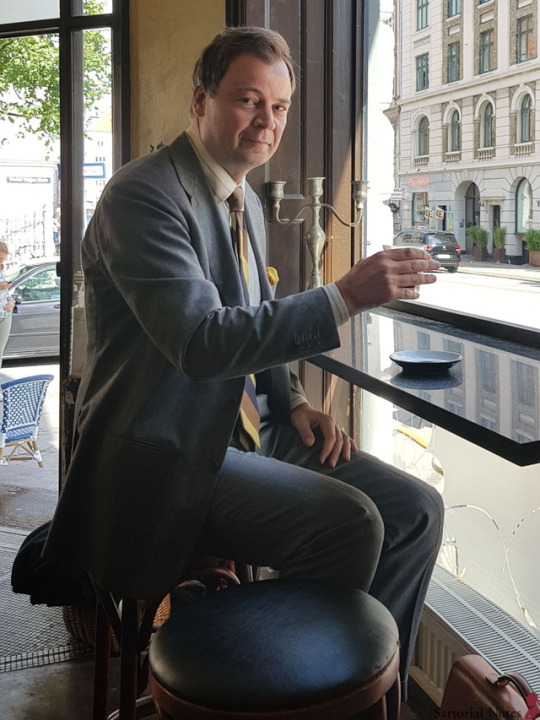
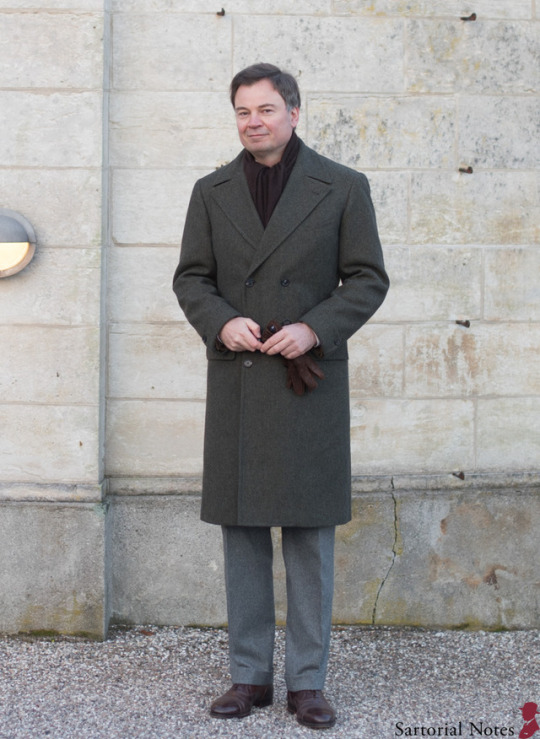
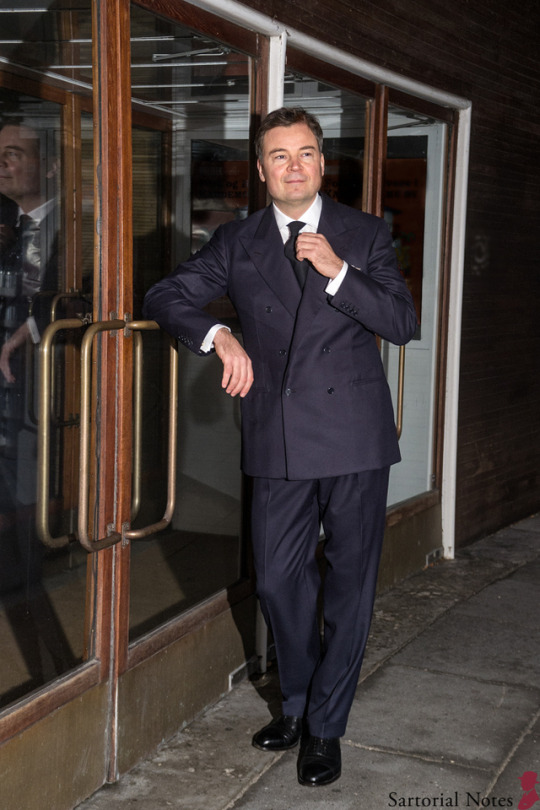

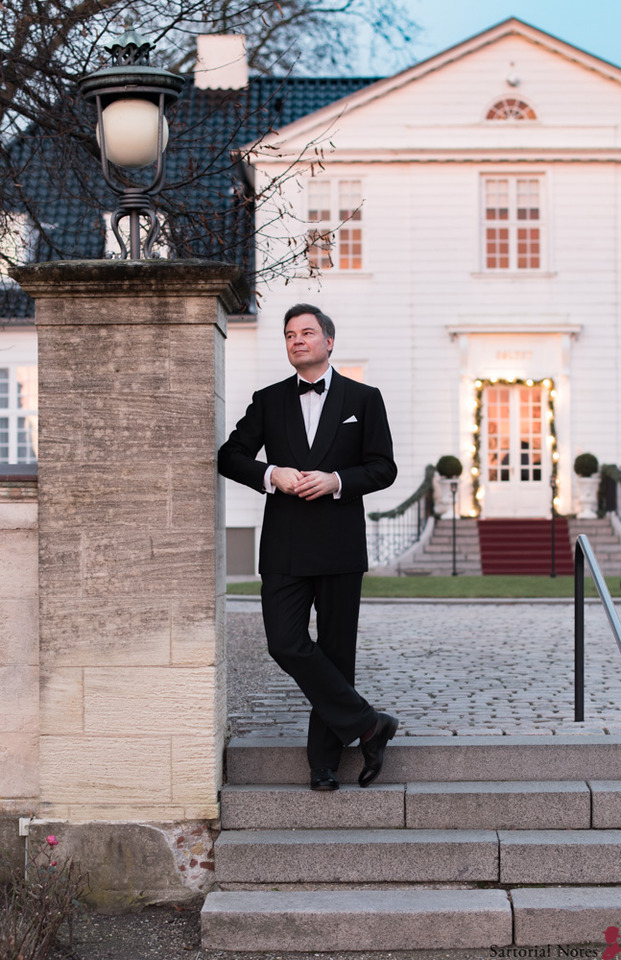
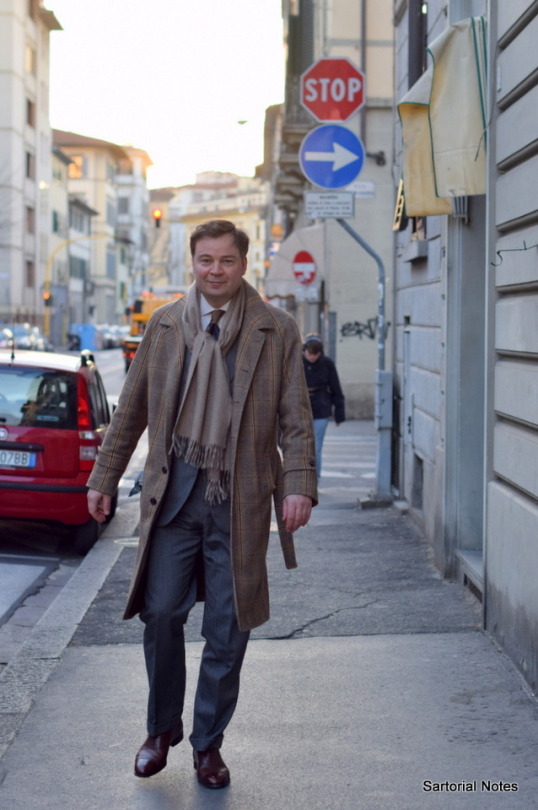

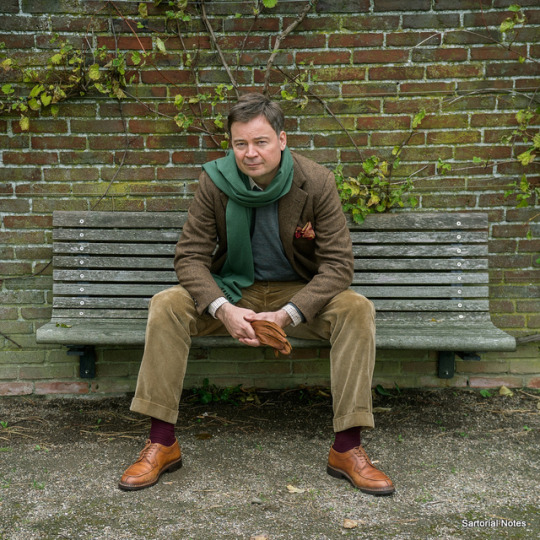
Real People: Riding the Line
It’s been almost fifty years since men have worn tailored clothing en masse. The hippie revolution of the 1970s did a lot for what Bruce Boyer has called prole clothes -- those items in our wardrobes that take inspiration from the working class. Things such as jeans, chambray shirts, army field coats, motorcycle jackets, and white tees are no longer just the uniform of blue-collar workers. Plus, with the spread of the “casual Friday” movement -- which started in the ‘90s and has continued since -- it’s become all but impossible to wear a formal suit outside of certain environments.
That said, tailoring has gone through somewhat of a revival in the last ten years. Some men are making an effort to dress up again, but while the coat-and-tie hasn’t been widely popular since the 1960s, people still want to look different from the previous generation’s dressers. Clothiers often tell me how customers want to look less stuffy, less conservative, and less formal. Even Thom Browne -- who has heavily borrowed from that mid-century Man in a Gray Flannel Suit look -- has had to reinvent the style in order to get people to buy things.
I also like tailoring that’s a bit more interesting -- something that’s a bit less staid than traditional business dress. That question is how do you ride the line between something expressive and something that looks like it belongs at Pitti Uomo. A step too far and suddenly your outfit becomes a costume.
Torsten in Copenhagen is one of the few men I know who ride this line exceptionally well. By day, he works as a project manager in communications, web, and government. By night, he runs one of my favorite men’s style blogs, Sartorial Notes. Torsten’s sense of style leans towards the classic end of things, but it’s never overly retro or anachronistic. It also looks at home in a modern setting in a way that feels natural and comfortable.

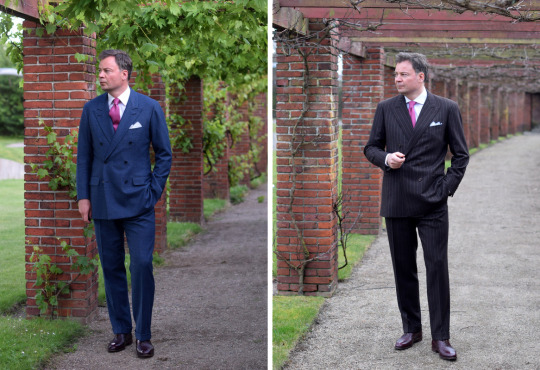
Torsten is fortunate enough to have things made for him, often by some of the world’s best tailors -- Volkmar Arnulf in Berlin, Loris Vestrucci in Florence, Francesco Guida in Prato, and Malcolm Plews in London. And in doing so, he’s been able to worry less about fit and focus more on silhouette. In the photos immediately above, you can see how two double-breasted suits -- both 6x2 configuration with notch lapels and a similar gorge line -- can look completely different depending on how the shoulders are cut. The first has a softly padded shoulder line, giving the jacket a rounder and more relaxed look. The second, by contrast, is more angular and padded, giving it an authoritative sensibility. Both look great not just because they fit well, which should be the bare baseline for any outfit, but because they have a flattering silhouette.
It takes a while to train your eye towards these nuances, which is one of the advantages of having a good tailor (they can take care of these things for you). If you’re out shopping off-the-rack, however, beware of things that fit too slim. “Clothing should be accountable to your personal architecture, not fashion,” says Torsten. “Even men who get clothes made for them often go too tight -- I don’t think they’re aware of how strong the invisible hand of fashion trends can be. You notice they don’t feel relaxed in their suits, often they will leave the jacket open to feel comfortable.”
The fit and silhouette of your clothes are the baseline, the next step is about how you combine things. In some of the photos above, you can see Torsten’s use of patterns -- a vintage-styled checked overcoat, but cut in a modern way, or a block striped tie with a unique, almost retro use of goldenrod, mid-brown, and dark blue. Things feel classic without being boring; stylish without looking outlandish. On how to carefully ride this line, Torsten says:
I’m not fond of overly retro clothing. It’s too baroque, too playful. It’s more about expression than fit, and I’m too serious for those retro-centric styles. That being said, I like bringing vintage cloth to the tailor. A tailor can transform this artifact of the past into contemporary clothing with a bit of extra interest. I also think honesty and comfort are important to get clothing right. We all imitate, however it’s crucial that we don’t lose ground in that process. There must be a strong link between you as a person and the outer look. It shines through, if the link is missing. Again: it is about creating a strong link between you and your clothes, and fit is key. The rest - style! - will follow.

On this link, Torsten also thinks there ought to be a connection between your clothes and actual environment. For weekend wear, he ditches suits and sport coats and swaps in slightly more dressed-down chinos, jeans, oxford shirts, knitted pullovers, and soft leather shoes. “If I can speak about Danish brands, I think S.N.S. Herning and Andersen & Andersen are doing really fine jobs keeping a quality knit tradition alive,” he says. “I also like the Danish brand Duckfeet. They produce Blake stitched, full-grain leather shoes with a crêpe sole, which I wear on weekends.”
In the outfit above, you can see him in a traditional Icelandic sweater, some corduroy trousers, and those Duckfeet bluchers. “Reality is that, to dress down, sometimes you have to give up tailored clothing. Southern Italian suit jackets and sport coats are a great way to help dress down a coat-and-tie look, as they don’t scream out for a tie like a classic Savile Row coat. But at some point, I don’t see much sense in trying to turn formalwear into casualwear.”
As for what he considers essential in his personal wardrobe, he says:
If I could only have two suits, I would get one in a 300-400 gram navy herringbone, then another in a slightly mottled charcoal serge made from a similar weighted cloth. For sport coats, a brown Shetland tweed and grey herringbone Harris Tweed cover many days for me. I can pair them with tan cord trousers, grey flannels, and even blue jeans. And of course, there’s the blue hopsack blazer from a medium-weight fabric, which I find to be very versatile. Tailored clothing plays a smaller role in my life during the summer, but I do wear my tobacco brown linen suit often.
You can keep up with Torsten by following his blog, Sartorial Notes (it’s one of my favorite reads nowadays). He doesn’t update that often, but there’s a feature on the site where you can be notified by email whenever he does. He also posts some really nice streetstyle photography on his Instagram account.
(photos via Sartorial Notes)
32 notes
·
View notes
Text
EXTRA/ORDINARY: Craft and Contemporary Art - Maria Elena Buszek
I managed to get my hands on the book Extra/Ordinary written by Maria Elena Buszek. This was so insightful and I found it so informative, I learnt things that I previously was not aware of. In this anthology, it is split in to two sections “Redefining Craft: New Theory” and “Craft Show: In The Realm of “Fine Art””. I read through both of these sections and the individual chapters in each section too. Not all of this book is relevant to me so I have picked out the areas that I have found particularly useful and bits that have influenced me and given me information which benefits my studio work and wider knowledge.
I found that the Studio Craft movement, also known as, the Arts & Craft movement rose in the wake of the Industrial Revolution and was widely referred to as ‘honest’ and ‘transparent’. However, some were “led to a view that craft media are simply among many that may or may not serve any artist’s purpose in our contemporary art world”. It made reference to Craftivism which was a term coined to describe craft activism.
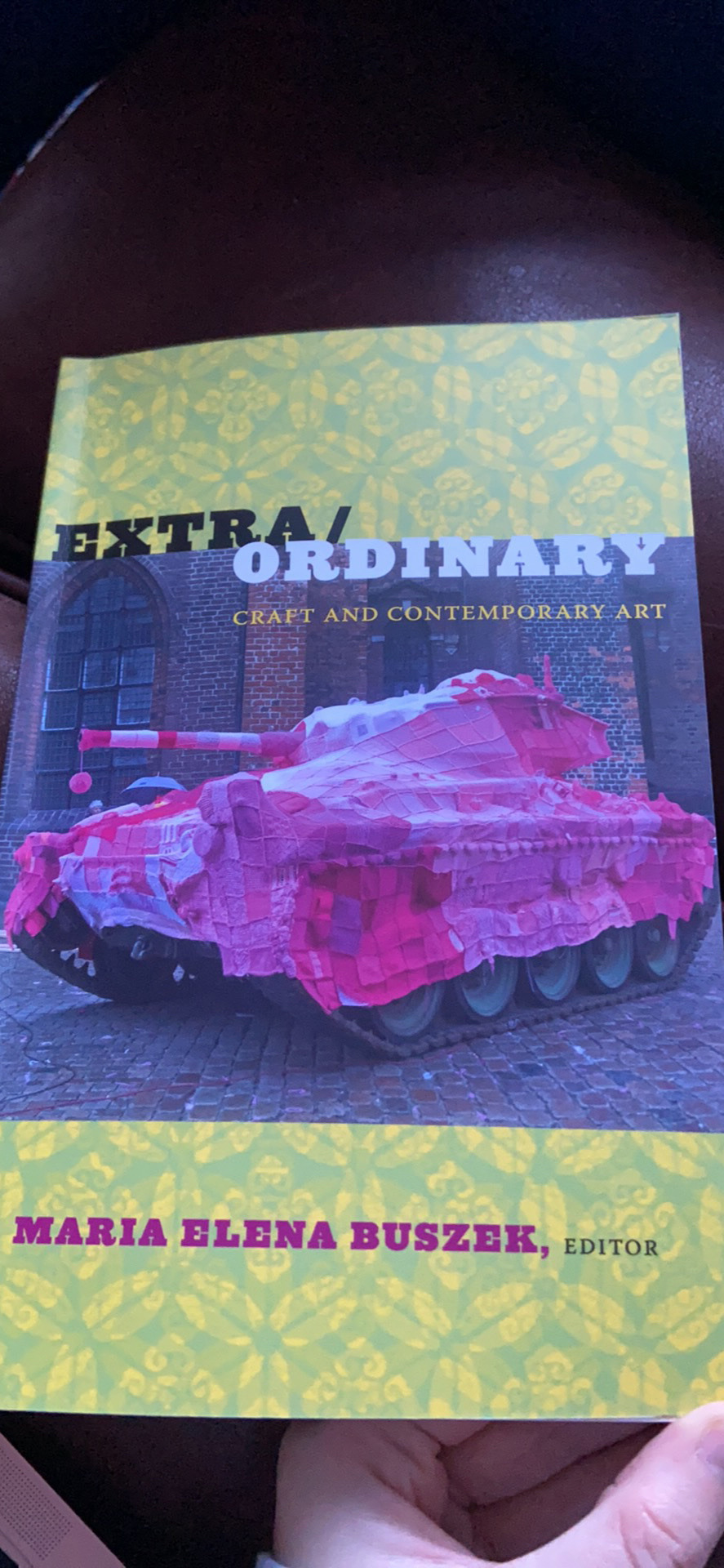
In the chapter, ‘How the Ordinary becomes Extraordinary: the modern eye and the quilt as art form’, it talks about the growth of seeing quilting as an art. Quilts were thought of as ordinary, everyday bedcovers that were pieced together by women in order to make warmth for their families, as well as make fabric last longer. Johnathan Holstein and Gail van der Hoof sparked a cultural understanding of quilts and began a radical transformation in the Summer of 1971 when they persuaded the Whitney Museum of American Art in NYC to display their quilt collection. This was significant because prior, quilting was never seen as a form of art, it was merely a hobby or a domestic job for women in the home. Over time, quilts transformed into autonomous artistic creations and were seen as being detached from traditional contexts and because of this art connoisseurs did not take them seriously as being a form of art. Holstein was very careful when planning his exhibition, he made sure his quilts resembled the same style as the paintings and were appropriate for a modern art museum. Over the years, as quilting became widely recognised, they were made not just for the decoration of a bed but also hung up on walls or had three-dimensional sculptural components.
In addition, they challenge the devaluation of women by a male dominant art world, using traditionally female media such as textiles. Artists like Judy Chicago, Faith Ringgold and Miriam Schapiro are examples of this. Faith Ringgold tells stories in her quilts which called attention to the ways in which the art world has excluded women and African Americans from the art world. They portray stories of the artist or messaged they want to convey. Feminist artists like herself use quilts to evoke women’s heritage and critique the dominant white male art world.
As well as quilting, it also talks about knitting. Artist Betsy Greer was a knitter and her work powerfully conveyed her anger and her thoughts surrounding poverty, welfare and, immigration and racism - without raising a single voice. This is significant because it highlighted how women used the form of craftivism to express their anger in a peaceful manner. It was her form of protest without yelling, she said that “in a heated debate, it is easy to be drowned out among the many voices”. Betsy Greer also created cross stitch pieces that were based on anti-war iconography, some people called it anti-war graffiti. This has given me ideas for my own work because I like the idea of being able to portray a powerful message in a peaceful way but gets the message across.

The chapter ‘Rebellious Doilies and Subversive Stitches’ makes reference to Rozsika Parker’s Subversive Stitch. Parker fought to get embroidery recognised as an important art form but was banished from the canon due to her gender. However, Parker was part of the 1970s and early 1980s feminist reclamation of craft as a liberating pass time but also, more importantly, a high art form. In the art world, artists such as Judy Chicago and Magdalena Abakanowicz broke down some of the barriers and in turn brought textile work into authoritative galleries and museums of North America and Europe. The “feminine qualities that were used to dismiss textiles as art forms were ironically reversed to demonstrate the peaceful nature of the protests versus the brutality of (masculine) police oppression and the wider politics that had brought the threat of nuclear war”. Feminist artists used their skills and created in groups to form bonds that challenged the destruction of their communities under contemporary capitalism. When groups of women got together to knit, their peaceful acts were used to highlight the violence of other activists and how they only took part in non-violent protests using their arts to shout their messages.

Marianne Jorgenson is a Danish artist who created the Pink Tank project. She collaborated this project with the Cast Off Knitters group and several knitters from around the world. For this project, they knitted over 4000 tiny squares which were then sewed together to cover this large tank. It was basically a huge tank blanket to portray the idea that when it is covered, it is seen as unarmed. The use of pink is significant because it is considered to be a feminine colour and not as threatening and the blanket gives the tank a physical presence, rather than a purely significant one. “The tank is a symbol of stepping over other people’s borders. When it is covered in pink, it becomes completely unarmed and it loses its authority.” This has given me ideas to play with my own work and context, how could I change the sense particularly violent objects are known to be? For example, I could change the way a knife is seen, if I cover it in a feminine fabric, would this remove the violence or fear?
0 notes
Text
Abortion
An old family friend who is voting for Trump fought with my mother yesterday. Stubbornly insisting that of course she was tired of Trump’s unsuitability and immorality—she even nodded towards the fact that there are at least 545 children in cages who may never see their parents again because of the government’s casual cruelty—she argued that all of that was white noise: she had to vote for Trump because of his staunch stance against abortion.
Our friend is not some weird outlier, not the only voter who is willing to make this inhumane bargain. Though Trump and many of his voters are the strangest and unlikeliest of bedfellows, the prospect of overturning “Roe v. Wade” makes what would otherwise be a bitter pill easily and readily swallowed.
But abortion was not invented by the Supreme Court in 1973 and, should “Roe v. Wade” be overturned, abortion will not disappear.
Abortions will continue no matter how draconian Republicans’ restrictions become.
What will change—and change dramatically—is the number of preventable and frequently fatal medical accidents and the prosecution of women, particularly women of color and women without financial means.
Sadly, the well-documented data that prove this are either ignored by the “pro-life” movement or considered an acceptable outcome.
At her confirmation hearing before the Judiciary Committee, Amy Coney Barrett remarked: “When I write an opinion resolving a case, I read every word from the perspective of the losing party. I ask myself how would I view the decision if one of my children was the party I was ruling against.”
Even a cursory glance at Barrett’s judicial record, however, reveals just how hollow these words ring. Unfortunately for the nation, Judge Barrett suffers from the same empathetic myopia that plagues much of today’s Republican party: too few are able to see the world beyond and outside of themselves.*
Too many on the far right, fueled by the gross tenets of Ayn Rand’s selfishness, tend to see themselves invariably as different, as special, as unique. From this distorted perspective, the vicissitudes of fortune visited upon them—unemployment during a pandemic, for instance—are extraordinary and fundamentally different from anything the hoi polloi might possibly encounter. Welfare in such a case as theirs is not an economics of dependency; rather, it is simply a bit of help to bridge the gap.
How might such a short-sighted, empathy-starved person react to an unplanned pregnancy?
Well, look no further than the number of wealthy, “pro-life” conservatives who procure abortions in the reddest of states. The statistics are as shocking as they are not.
So many of our laws and so much of our politics, purported to be black-and-white, contain amounts grey commensurate with income and power.
Even the language of pregnancy and abortion shifts according to one’s familial and financial circumstances:
The poor and powerless are “careless,” but the rich and powerful understand that “accidents happen.”
The poor and powerless are “horny,” but the rich and powerful understand that sometimes people get “carried away.”
A young woman without means must own her mistake and usher in a little life, but a young woman with a powerful father is helped to understand that we all make mistakes sometimes—that it would be unfair to let a single moment of indiscretion derail a life full of promise.
But we should make no mistake: the different worlds of experience following conception would not stop if abortion were criminalized.
For the rich, there are trips across the border: a Danish vacation, a weekend in Mexico.
For those unable to afford such an expense should the doors of Planned Parenthood no longer be open, there are hangers, knitting pins, and catheters flowing with Lysol—sepsis, nephrosis, and death.
Sadly, “pro-life” is just a clever marketing scheme: it sounds better than “anti-abortion” and, as a bonus, the label brilliantly implies that anyone who argues against such a stance must, perforce, be “pro-death.” As a label, it contains within it the extent of its argument.
But, like so many marketing schemes, “pro-life” is misleading and duplicitous! For truth in advertising, one should call “pro-life” instead “restricted access.” In the minds of so many on the far right, abortion should be an absolutely illegal activity—absolutely illegal except for those already well-versed in bending the rules to accommodate their own needs.
If, indeed, those who proclaim themselves to be “pro-life” actually believed all lives to be sacred and equally valuable, the Venn diagram of those opposed to abortions, to capital punishment, to cost-prohibitive healthcare, to drone strikes, to children in cages, and to sterilizations in ICE detention centers would be a circle.**
If “pro-life” voters are serious about their ethical beliefs, they should investigate the well-documented reasons women seek abortions. They might be interested to learn that many women who “choose” to have an abortion do not feel that they, in fact, have a choice.
That’s because a choice predetermined by economic circumstances or by physical and mental health requirements is not a choice!
Knowing that, and if they were serious about their professed ethics, they would be in the front lines agitating for paid parental leave; affordable childcare; universal, cost-free Pre-K education; access to fresh, healthy food; comprehensive sex education in public schools; and restrictions on pollutants and weapons.
But they’re not.
And the politicians they elect proceed accordingly: they care more about exerting control over the bodies of women—particularly over women of color and women without financial means—than they care about life after birth.
Support a woman’s right to choose.
To do that, support policies that make such a personal choice truly a choice.
Pictured below is the dedication to Gloria Steinem's memoir "My Life on the Road."
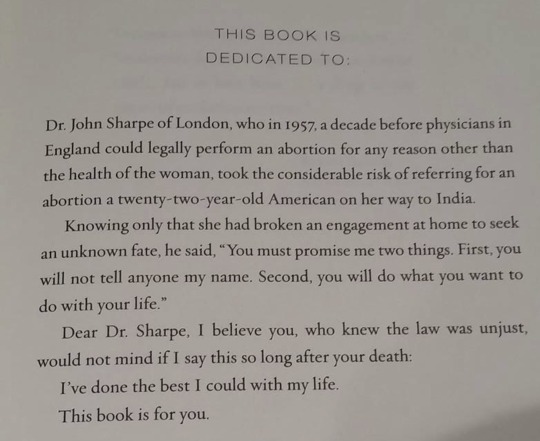
* Some, however, are saved when their eyes are opened by events outside their control. To take Tennessee Williams out of context: “They had failed their eyes, and so they were having their fingers pressed forcibly down on the fiery Braille alphabet” of understanding. Some aspect of their life — unseen and unanticipated on the radar — appears, altering a carefully constructed way of seeing. Maybe it’s a son who comes out of the closet and helps a conservative mother to see and to understand how narrow the confines of her empathy are when compared to her love for him. Or maybe it’s the seemingly ubiquitous epiphany among elected Republicans — “What if that happened to my daughter?” — that nudges them towards addressing workplace harassment and gendered wage discrepancies.
** It is not a circle.
0 notes
Text
PHOT202: Stop Motion Photography History.
1895-1928: The silent film era:
It is estimated that 80 to 90 percent of all silent films are lost. Extant contemporary movie catalogs, reviews and other documentation can provide some details on lost films, but this kind of written documentation is also incomplete and often insufficient to properly date all extant films or even identify them if original titles are missing. Possible stop motion in lost films is even harder to trace. The principles of animation and other special effects were mostly kept a secret, not only to prevent use of such techniques by competitors, but also to keep audiences interested in the mystery of the magic tricks.
Stop motion is closely related to the stop trick, in which the camera is temporarily stopped during the recording of a scene to create a change before filming is continued (or for which the cause of the change is edited out of the film). In the resulting film the change will be sudden and a logical cause of the change will be mysteriously absent or replaced with a fake cause that is suggested in the scene. The oldest known example is used for the beheading in Edison Manufacturing Company's 1895 film The Execution of Mary Stuart. The technique of stop motion can be interpreted as repeatedly applying the stop trick. In 1917 clay animation pioneer Helena Smith-Dayton referred to the principle behind her work as "stop action", a synonym of "stop motion".
French trick film pioneer Georges Méliès claimed to have invented the stop-trick and popularized it by using it in many of his short films. He reportedly used stop-motion animation in 1899 to produce moving letterforms.
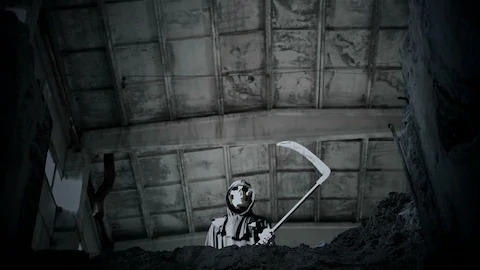
Segundo de Chomón:
French filmmaker Segundo de Chomón (1871–1929) made many trick films in France for Pathé. He has often been compared to Georges Méliès as he also made many fantasy films with stop tricks and other illusions (helped by his wife, Julienne Mathieu). By 1906 Chomón was using stop motion animation. Le théâtre de Bob (April 1906) features over three minutes of stop motion animation with dolls and objects to represent a fictional automated theatre owned by Bob, played by a live-action child actor. It is the oldest extant film with proper stop motion and a definite release date.
The Sculptor's Nightmare
Segundo de Chomón's Sculpteur moderne was released on 31 January 1908 and features heaps of clay molding itself into detailed sculptures that are capable of minor movements. The final sculpture depicts an old woman and walks around before it's picked up, squashed and molded back into a sitting old lady.

1930s and 1940s:
Starewicz finished the first feature stop motion film Le Roman de Renard (The Tale of the Fox) in 1930, but problems with its soundtrack delayed its release. In 1937 it was released with a German soundtrack and in 1941 with its French soundtrack.
Hungarian-American filmmaker George Pal developed his own stop motion technique of replacing wooden dolls (or parts of them) with similar figures displaying changed poses and/or expressions. He called it Pal-Doll and used it for his Puppetoons films since 1932. The particular replacement animation method itself also became better known as puppetoon. In Europe he mainly worked on promotional films for companies such as Philips. Later Pal gained much success in Hollywood with a string of Academy Award for Best Animated Short Films, including Rhythm in the Ranks (1941).

1960s and 1970s :
British television has shown many stop motion series for young children since the 1960s. An early example is Snip and Snap (1960-1961) by John Halas in collaboration with Danish paper sculptor Thok Søndergaard (Thoki Yenn), featuring dog Snap, cut from a sheet of paper by pair of scissors Snip.
Apart from their cutout animation series, British studio Smallfilms (Peter Firmin and Oliver Postgate) produced several stop motion series with puppets, beginning with Pingwings (1961-1965) featuring penguin-like birds knitted by Peter's wife Joan and filmed on their farm (where most of their productions were filmed in an unused barn). It was followed by Pogles' Wood (1965-1967), Clangers (1969-1972, 1974, revived in 2015), Bagpuss (1974) and Tottie: The Story of a Doll's House (1984).
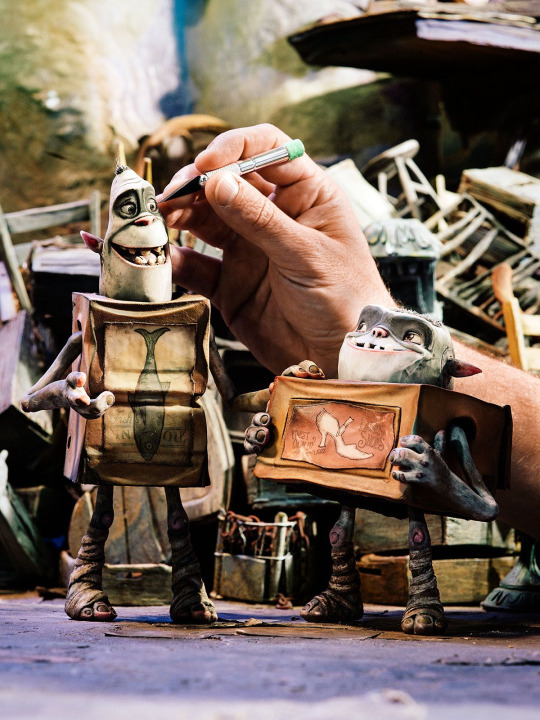
21st century:
The BBC commissioned thirteen episodes of stop frame animated Summerton Mill in 2004 as inserts into their flagship pre-school program, Tikkabilla. Created and produced by Pete Bryden and Ed Cookson, the series was then given its own slot on BBC1 and BBC2 and has been broadcast extensively around the world.
Other notable stop-motion feature films released since 2000 include Fantastic Mr. Fox (2009) and $9.99 (2009), and Anomalisa.
In 2003, the pilot film for the series Curucuru and Friends, produced by Korean studio Ffango Entertoyment is greenlighted into a children's animated series in 2004 after an approval with the Gyeonggi Digital Contents Agency. It was aired in KBS1 on November 24, 2006 and won the 13th Korean Animation Awards in 2007 for Best Animation. Ffango Entertoyment also worked with Frontier Works in Japan to produce the 2010 film remake of Cheburashka.
Variations of stop motion:
Stop motion has very rarely been shot in stereoscopic 3D throughout film history. The first 3D stop-motion short was In Tune With Tomorrow (also known as Motor Rhythm), made in 1939 by John Norling. The second stereoscopic stop-motion release was The Adventures of Sam Space in 1955 by Paul Sprunck. The third and latest stop motion short in stereo 3D was The Incredible Invasion of the 20,000 Giant Robots from Outer Space in 2000 by Elmer Kaan and Alexander Lentjes. This is also the first ever 3D stereoscopic stop motion and CGI short in the history of film. The first all stop-motion 3D feature is Coraline (2009), based on Neil Gaiman's best-selling novel and directed by Henry Selick. Another recent example is the Nintendo 3DS video software which comes with the option for Stop Motion videos. This has been released December 8, 2011 as a 3DS system update. Also, the movie ParaNorman is in 3D stop motion.
LINKS:
https://en.wikipedia.org/wiki/Stop_motion
0 notes
Text
Am I a Witch? How to Tell If You're a Witch

Layne Holmes
Signs and characteristics of the modern witch
How Can You Tell If Someone Is a Witch?
While there are many kinds of witches, witchcraft, and traditions, witches all have one thing in common: they are attuned to the energy of the universe. This attunement may have arisen naturally—perhaps a child was born sensitive, born in sync with nature, or encouraged to absorb the natural world around them. On the other hand, an individual may have more commonly chosen their path towards witchery.
What Do Witches Look Like?
The whole portrayal of the cackling witch with the black robe, black hat, striped socks, black cat, and witch's broom is far outdone and greatly inaccurate. There are many witches walking among us practising and flowing with the sync of daily life, and they may present themselves in any way they choose.
Witches are men or women who use the energy of the universe to do work. So whether a wise-woman wears her natural, long, grey hair and a knitted cover-up, or a man wears sleek, black clothes, silver adornments, and a hat, there's really no telling who is a witch and who isn't from an outer appearance.
Am I a Witch?
You may have been musing over the question "Am I a Witch?" for a while, or maybe you tuned into the recent adaptation of Sabrina the Teenage Witch called The Chilling Adventures of Sabrina, and felt a little tickle in your hair. Let's take a look at the signs and characteristics that define a contemporary or modern witch.

Witches feel at home when immersed in nature
You're Synchronised With Nature
This is one of the most telltale signs, in my opinion. Witches work with the energy of the earth and nature. They sync many of their practices to the lunar and solar phases. Have you ever felt charged or felt the need to perform a ritual on a full moon or new moon? Have you ever felt more at peace in nature—deep in a forest or near a body of water—than inside a house or in a crowded public place?
Feeling at home in nature is a good indication that you have witch potential—when you're in it, you feel compelled to bath in the river, touch the trees, lay in the moss, put your feet in the ocean, listen to the birds, and appreciate the sound of dew in the trees. Your senses are essentially heightened when you are submerged in the natural world.
You Perform Rituals
Rituals here are loosely defined. Rituals can be anything from cleansing your room on a certain lunar phase to feeling the need to bury items in the earth. Maybe you gather items, and your intuition moves you to arrange them a certain way or combine them in a certain way. Perhaps you take herbs regularly, not necessarily because someone told you to, but because they feel good in your body. If you have natural tendencies like those described above, you are likely tapping into the universal energy.

Familiars need not be the common black cat
You Communicate With Animals
You will definitely know who you are if you fit into this category. Are animals drawn to you, and are you drawn to animals? If animals take to you natural—including wildlife—and they appear in your life in high frequency, it is likely that you are "neutral" or attractive to them. Whereas the average human's energy may clash with that of non-human animals, witches tend to attract. This can be anything from neighbourhood cats to an owl or deer that reappears in your yard regularly. You may have found that many animals "find you" in your lifetime. This is a good sign.
Your Intuition Is Strong
Have you ever looked through someone? That is, can you see beyond what they are conveying? If you've ever heard someone speak but knew more than what they were telling you, or had a bad or good feeling about someone without knowing them, this may indicate that you are likely attuned to the universal energy. Trusting your intuition means you have a strong feeling in your "gut." This extra sense often leads you to the right answer about a situation, the right path, person, or thing whether present, past, or future.
You Have a Familiar
In the Dark Ages, "familiars" were not talked about quite as lightly as they are today and were actually thought to be demons by Christians. Neo-pagans and modern witches have a much different view and often refer to their household animal companion as their familiar. Familiars don't have to be your stereotypical black cat; they can be dogs, rabbits, wolves, owls, and other wildlife.
What Is a Familiar?
Familiars are souls that have returned again and again to reconnect with the witch they are drawn to—hence the term "familiar." Spirit guide animals tend to be smarter, deeper, more attuned, and even more "human-like" in many ways than most domesticated pets.

Herbs are commonly used in healing and magickal spell-casting.
You Collect Natural "Tools"
Perhaps when you stroll out in nature, you are always coming across bones, shells, feathers, precious stones, abalone shells, or natural anomalies. If you have collected these items over the years, you may have been collecting them to "do work." Learning how to use them will often require the guidance of a seasoned witch or a little bit of research on your end.
You Have an Understanding of Herbs
Herbs are of great use to witches. Herbalism or herbology is simply the use of herbs to cure or treat physical, mental, emotional, spiritual, or psychic ailments. Herbs can be used in craft for protection, communication, abundance, and for similar intentions. If you use herbs regularly and have a natural, unexplained tendency towards working with them (and working with them effectively and safely), this is a good indicator of your magickal tendencies.
You Are Wise
There is no ruling about whether or not someone can be too young to be a witch, although one should not practice witchcraft at a young age unless properly guided. Life experience and maturity is a huge indication of ones' magickal abilities. Witches tend to observe and assess and act accordingly. Witches, too, have a healthy and respectful understanding of life events like birth and death.
You're Introverted by Choice
Many witches have work to do. If you find yourself overwhelmed by busy places like malls, theme parks, etc. and avoid them entirely for peace of mind, you may simply be protecting or keeping your natural abilities healthy. The side effects of polluted energy present as headaches, moodiness, and fatigue. Some people can be energy vampires, and witches much prefer to be in contemplative settings away from chaos and busy happenings—unless with their coven.

Witches use the gifts of the earth to cast spells and do work.
You Sense Energy
Much like seeing through people (not to be confused with psychic or clairvoyant abilities), you can feel the energy of people and the places that surround you. Witches often can assess an environment or an object's energetic field. If an object has been cursed or used in dark practices, they will know. On the other hand, if a space has light energy or an object has been used in good, benevolent practices, a witch will know.
Technology Is Hit or Miss
Too much computer, television, or screen time for anyone can have detrimental effects, but for witches, in particular, technology can feel poisonous. If a witch is surrounded by too much technology, they may start to feel mental fog from electromagnetic pollution. This is not the case for all witches, however, as some may use technology freely and without issue.
You Are Open-Minded
Witches find themselves attracted to other unusual, obscure, or atypical individuals. You will rarely find them spending time with individuals who don't dapple in the arts. They have a healthy respect for practices such as tarot, astrology, energy healing, and similar modalities. Someone's belongings too may reflect an openness to witchery. Perhaps you have books on witchcraft, have collected magickal tokens from travel and other cultures, and maybe you have a healthy collection of living plants in your home.
Storms and Natural Events Charge You
If you feel your spirit stir at the sight of lightning, the sound of thunder, the crashing of waves in a storm swell, or the rush of heavy winds, this is a strong indication. Witches tend to work with nature and natural energy, so any kind of divergence from the status quo is a perfect opportunity for work and recharge. For them, nothing is more thrilling than sensing the movement of the universal energy.

Witches work closely with solar and lunar phases.
What Kind of Witch Am I?
It is important to know that there are many different types of witches and witchcraft and it is important that you take the time to explore the differences to get an idea of a number of practices and traditions. Many individuals have heard of the term "Wicca." Wicca is a form of modern paganism that originated in the 1950s and is based on very peaceful, harmonious, and balanced practices.
Voodoo, shamanism, psychism, etc. are terms that should be respectfully distinguished and not confused with witchcraft. In addition, witchcraft is acknowledged across cultures and languages, for example: brujeria (Spanish), bruxa (Portugeues), heks (Danish), etc.
What Is Paganism?
Paganism refers to individuals who follow a spiritual path based around the earth and earth's energy. Paganism is used as a broad term to describe many different belief systems. Not all pagans are witches.
Were Your Relatives Witches?
There is the misconception that individuals are "natural-born" witches. This is not always the case. If your relatives were known witches and practised witchcraft, you may indeed have witchy potential, but as mentioned, being a witch is a path that any man, woman, or individual can choose to pursue and embrace if it speaks to them.
Is a Witch a Sorcerer, Sorceress, Warlock, Wizard, or Wizardess?
A male or a female who has chosen the path is simply a witch. Sorcerer, sorceress, warlock, wizard, and wizardess are closely related terms but are not often used by witches. These terms generally refer to conjurers but are often kept far separate from those who practice witchcraft and self-identify as witches.

Witches tend to do introspective work.
How Can I Be a Witch?
Rather than deciding "I want to be a witch," it's better to approach the curiosity with deep respect and thought. Practising witchcraft and magick is a serious life decision and should be thought about carefully, responsibly, and respectfully.
It is important to do your reading, research, and to work with experienced individuals who have been practising for some time and have a deep understanding of the craft. Be wary of strict practices and practices that appear to do work for malevolent reasons.
Simple Ways to Embrace Witchery for Beginners
Love the Living. Some witches choose to adopt a plant-based (vegan or vegetarian) diet. This is a personal decision and is not mandatory, however, many describe it as soul-cleansing.
Collect Nature's Gifts. When you are immersed in a natural environment, pay close attention to objects and items that would do well in your living space or at a personal altar. Collecting the gifts of the seasons and arranging them respectfully is a good way to honour the earth.
Be in Sync With the Moon. It is important to be attuned to the moon phases. Many spells and rituals will commence on new moons, full moons, and during special lunar or solar events. There are lunar phase charts you can find at crystal shops and metaphysical shops, or online. Also, consider celebrating the lunar phases with ritual and by setting intentions. New moons are good for releasing the unwanted.
Care for the Animals. Offer hummingbirds feed in the winter months and birds water in the summer. If you live in an urban area, consider volunteering or simply stopping in and saying hi to homeless shelter animals. Who knows? Maybe you will find your familiar.
Lessen Your Load. You can show your love and connection to earth by reducing your production of waste, cutting single-use plastic, and eating a more natural and local diet. Reuse containers, buy less packaged foods and reduce junk food from your diet. Also, consider eating seasonal foods to sync your body up with nature.
Immerse Yourself in Nature. Go for nature walks and nature strolls. Touch the earth as you feel drawn to it. Listen to the birds. Neutralise your energy and observe the wildlife around you—welcome them and enjoy any moments of connection you may experience by respectfully acknowledging them as they show themselves.
Do Your Reading and Journaling. Before you get started on spells, go to your local library, bookstore, or research books online that will help you prepare for your first spell casting. Work with light, work benevolently, and work for the greater good. Start working on your Book of Shadows or grimoire—your journal of spells, secrets, and rituals.
Video: The Book of Shadows

https://exemplore.com/wicca-witchcraft/How-to-Tell-If-Youre-a-Witch
0 notes
Text
Im so Danish even my blood cells are red and white shirt
Men's casual-fit raglan Im so Danish even my blood cells are red and white shirt .T-shirt cut to fall slightly below the waist. Made from a cotton-blend fabric — has a solid-color design with contrasting fabric on the neckline, banded cuffs and shoulder seams. Long-sleeve tee comes complete with a pullover design and crew neck.offers sophisticated style with a seamless edge. A high neckline combines with the looser fit for a naturally, subtly flowy silhouette, while the solid color keeps the look perfectly polished. Side slits add a touch of detail and movement, and flare sleeves complete the look with just a hint of drama.A lot that goes into creating a maternity tee that mamas love well after baby arrives: fit, fabric, feel. We fit this top on real pregnant moms who loved the super soft pima cotton blend and the stretchy fit. Celebrate your favorite spirit with the Fireball® Tee Shirt. This men's graphic tee is soft and comfortable and shows off your quirky side with a nod to your whisky of choice.
Im so Danish even my blood cells are red and white shirt, hoodie, sweater, longsleeve and ladies t-shirt
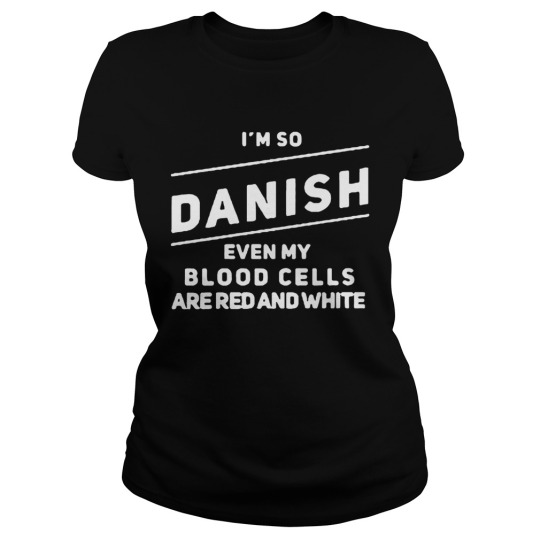
Im so Danish even my blood cells are red and white Classic Ladies
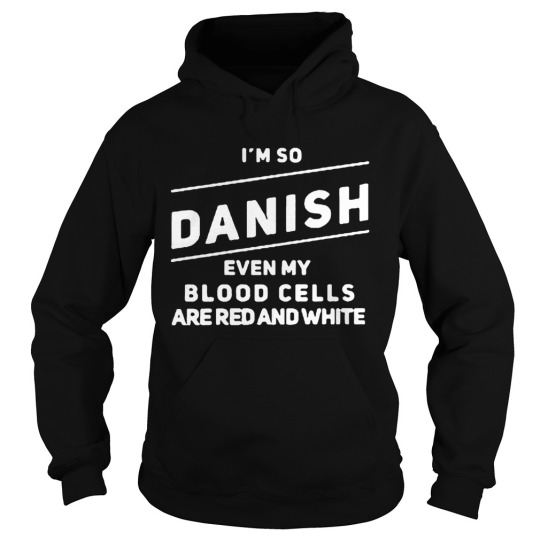
Im so Danish even my blood cells are red and white Hoodie
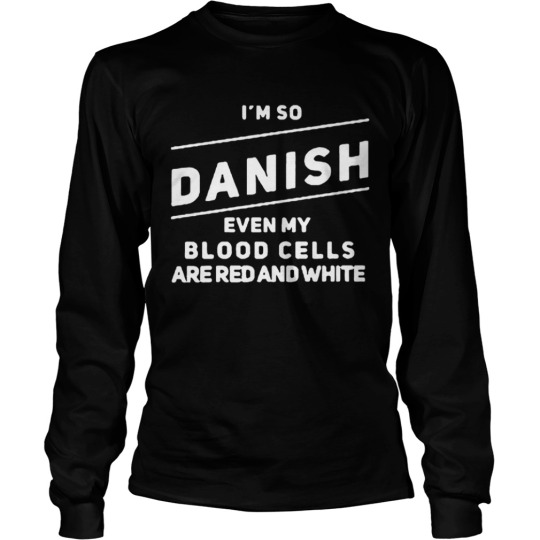
Im so Danish even my blood cells are red and white LongSleeve

Im so Danish even my blood cells are red and white Sweatshirt
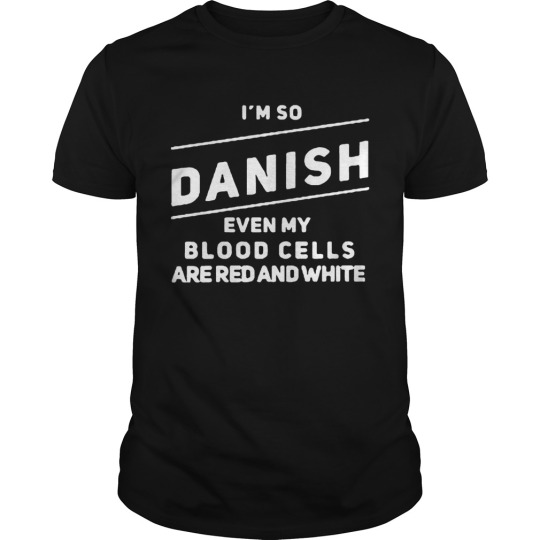
Im so Danish even my blood cells are red and white Unisex
A long sleeve maternity and nursing top that you'll love now and later Im so Danish even my blood cells are red and white shirt . The stretchy fabric accommodates a growing belly, while the snap placket allows easy feeding access. Double layer fabric over the bust and the easy access from above offer coverage to keep you comfortable.Men's black pullover T-shirt with long-sleeves and rib-knit front. Designed with contrasting neon-yellow stripes down the sleeves, finished off with banded cuffs. Men's pullover T-shirt cut to fall below the waist in a casual fit.Men's long-sleeve hooded T-shirt in solid gray with textured detailing. Made from cotton-blend fabric and cut to fall below the waist — designed with basic sleeves and an adjustable drawstring hood.Keep a smile on your face all day when you're wearing the Harry Potter Men's Deathly Hallows T-Shirt Gray. This Harry Potter t-shirt is designed to have a magical effect on your mood with quirky mirth.
You Can See More Product: https://hottrendtees.com/product-category/trending/
Read the full article
0 notes